Are you bringing home baby chicks for the first time, or need a refresher on how to best take care of them? While it might seem a little daunting to care for day-old chicks, it’s not at all difficult—and it’s an incredibly fun and rewarding aspect of keeping chickens.
In over a decade of raising my own chicks, I’ve learned a few things and changed a few things—namely, how to streamline the first eight weeks and keep messes to a minimum.
For the beginner, this is everything I know about raising healthy chicks at home!
Quick tip
Spring is the most common time to raise chicks because while they need to start off inside your home under a heat lamp, the weather should warm up enough by the time your chicks are fully feathered and ready to live outside.
Disclosure: If you shop from my article or make a purchase through one of my links, I may receive commissions on some of the products I recommend.
Before they come home
Whether you’re bringing home chicks from a farm or feed store, having them shipped to you, or hatching the eggs yourself, the preparation is all the same. Your chicks will need warmth, food, and water as soon as they arrive, so it’s important to have all the essential supplies (listed below) ready and waiting for them.
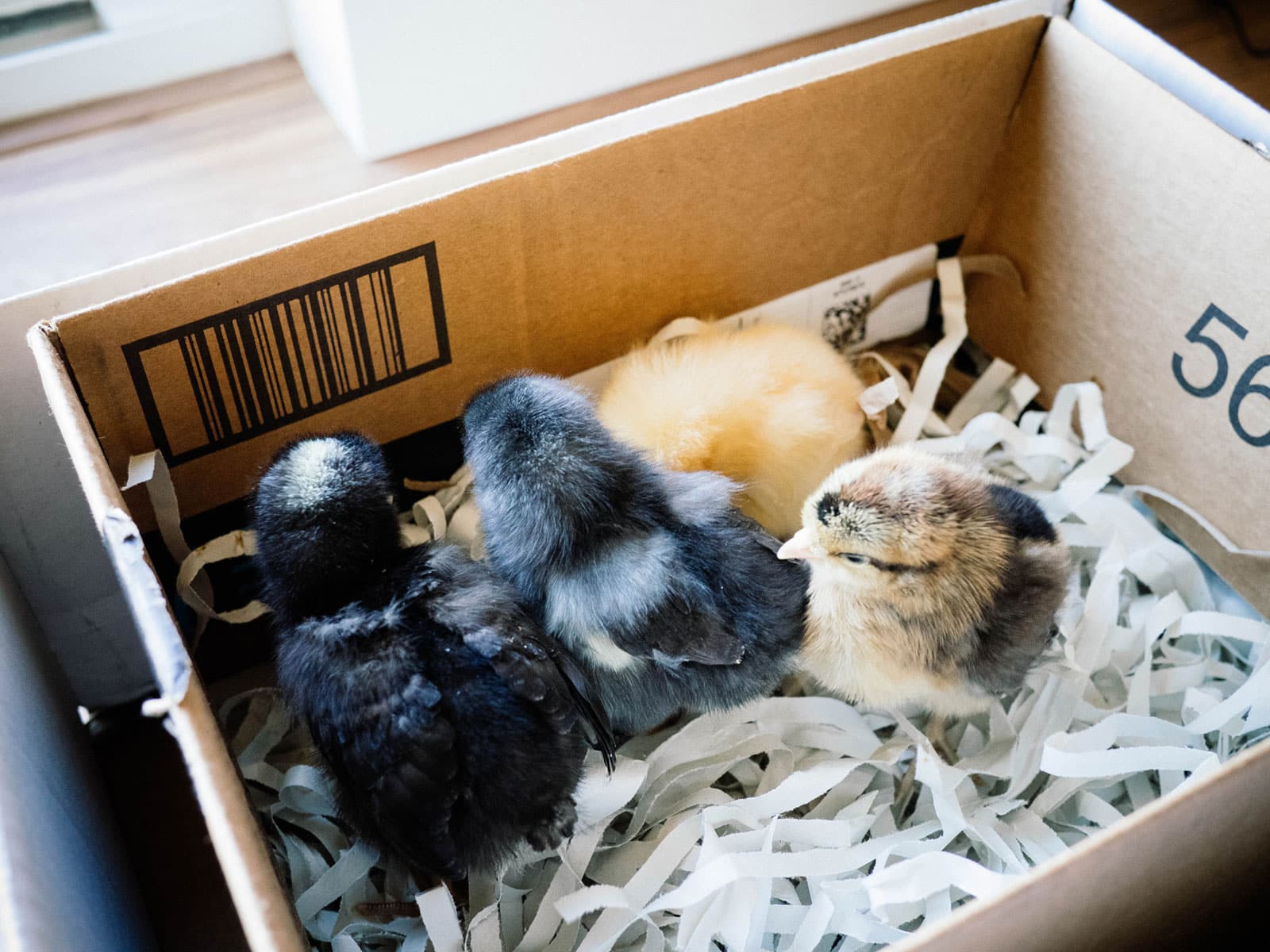
Essential supplies
This is what you’ll need for raising baby chicks:
- A brooder box, which will serve as their temporary home for the next six to eight weeks. (I share some ideas below.)
- A heat source for the brooder, such as a classic red heat lamp or a radiant heat plate. If you use a heat lamp, you’ll need the whole set (bulb, reflector and bulb guard) and a safe place to mount the lamp securely.
- A small thermometer to monitor the brooder temperature at floor or chick level.
- Absorbent non-slip bedding material for the brooder. Popular options include puppy training pads, pine or aspen shavings, coarse sand, chopped straw, or wood pellets. Avoid using newspaper (which is too slippery for little feet and can lead to spraddle leg), cat litter, or cedar products.
- Chick feed for the first eight weeks.
- Food and water containers designed for chicks, such as this feeder and this small mason jar fountain. (Or you can go with this starter set with adjustable legs.)
Shopping list
Note: This heat plates comes in two sizes, one rated for “up to 20 chicks” and the other for “up to 35 chicks.” In my experience, the smaller model is really more ideal for up to six baby chicks as they’ll be using it for a few weeks, so any more than that will quickly outgrow the space underneath the heat plate.
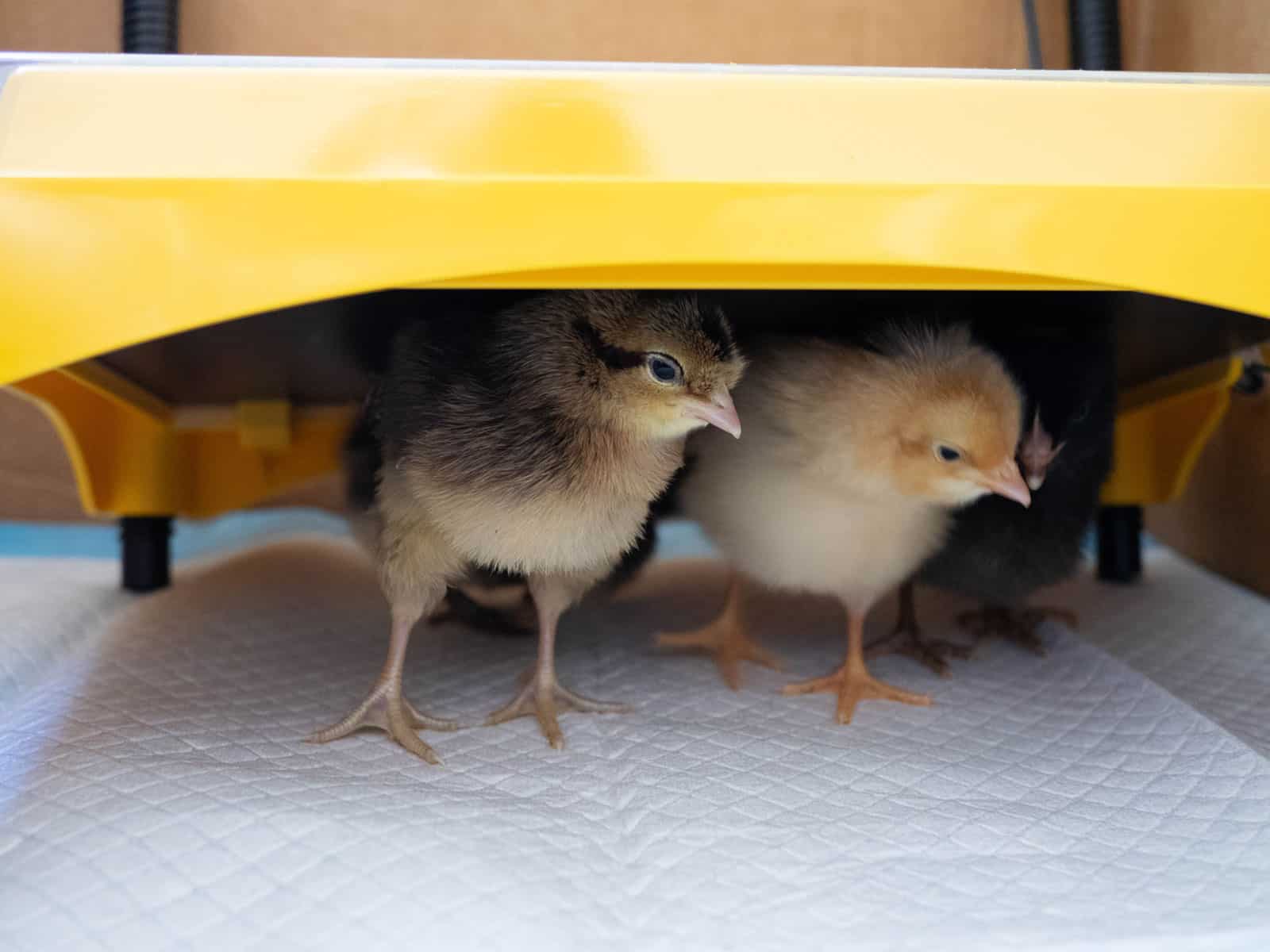
How to set up a chick brooder
A chick brooder (or brooder box) is simply an enclosed space that keeps your chicks safe and warm for their first few weeks of life before they can live outside. It’s essential for chicks that are raised without a mother hen, since they don’t have the benefit of being tucked under the mother’s body.
In your home, the brooder has everything the chicks need to survive: heat, food, and water.
If you’re raising just a handful of chicks, the easiest DIY brooder is a large cardboard box. (This is what I still use, at least for the first two weeks.)
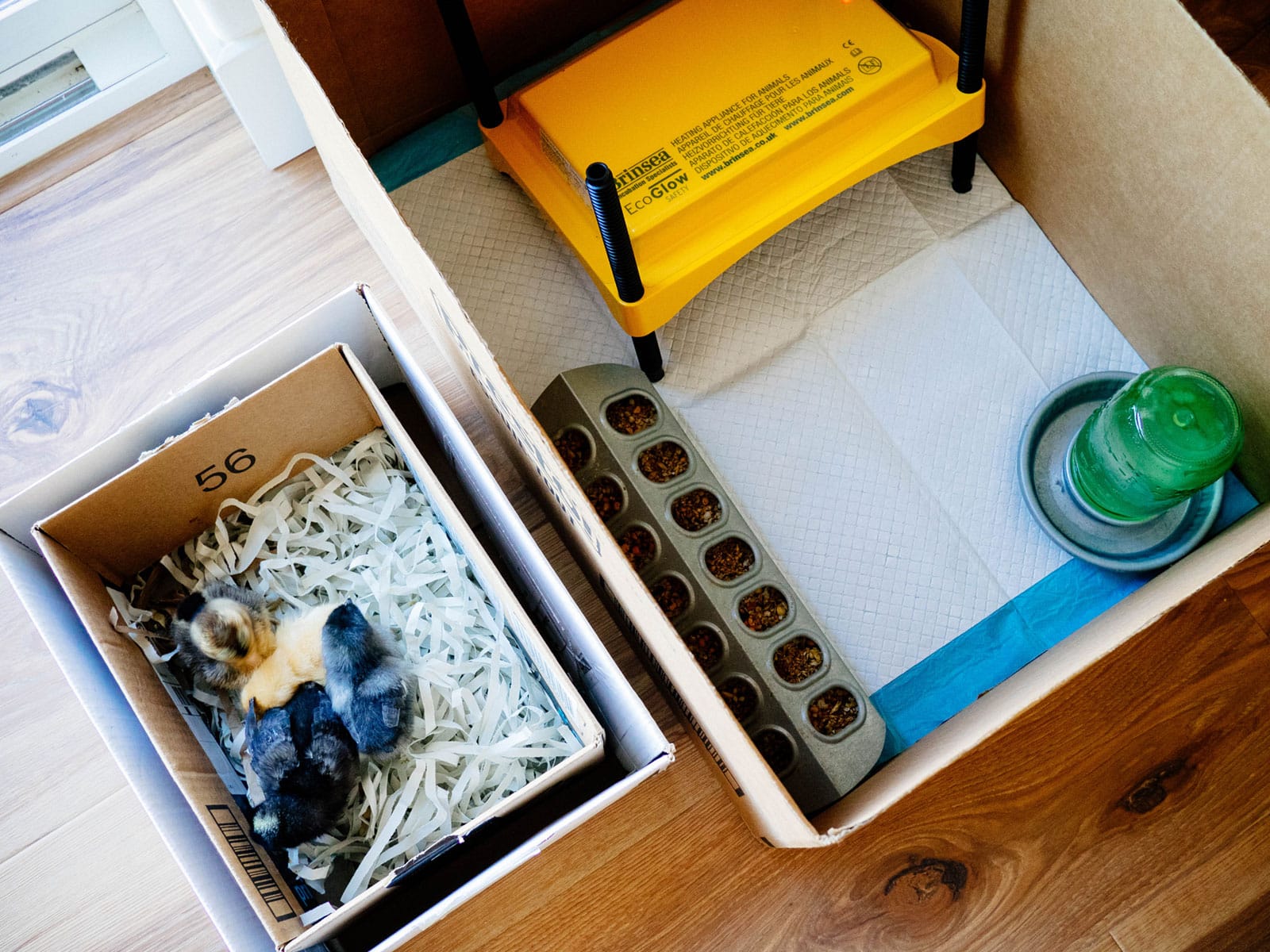
But you can also make a brooder out of a large plastic storage bin, stock tank, animal crate, portable puppy playpen, or other sturdy enclosure. Line it with your bedding material of choice.
If you have pets or rambunctious toddlers, the brooder should have a secure, breathable, and removable lid (made from chicken wire or hardware cloth) to keep those threats out while keeping your chicks in. After a couple weeks, most chicks can easily hop on top of (or even over) the walls as they practice their newfound flying skills!
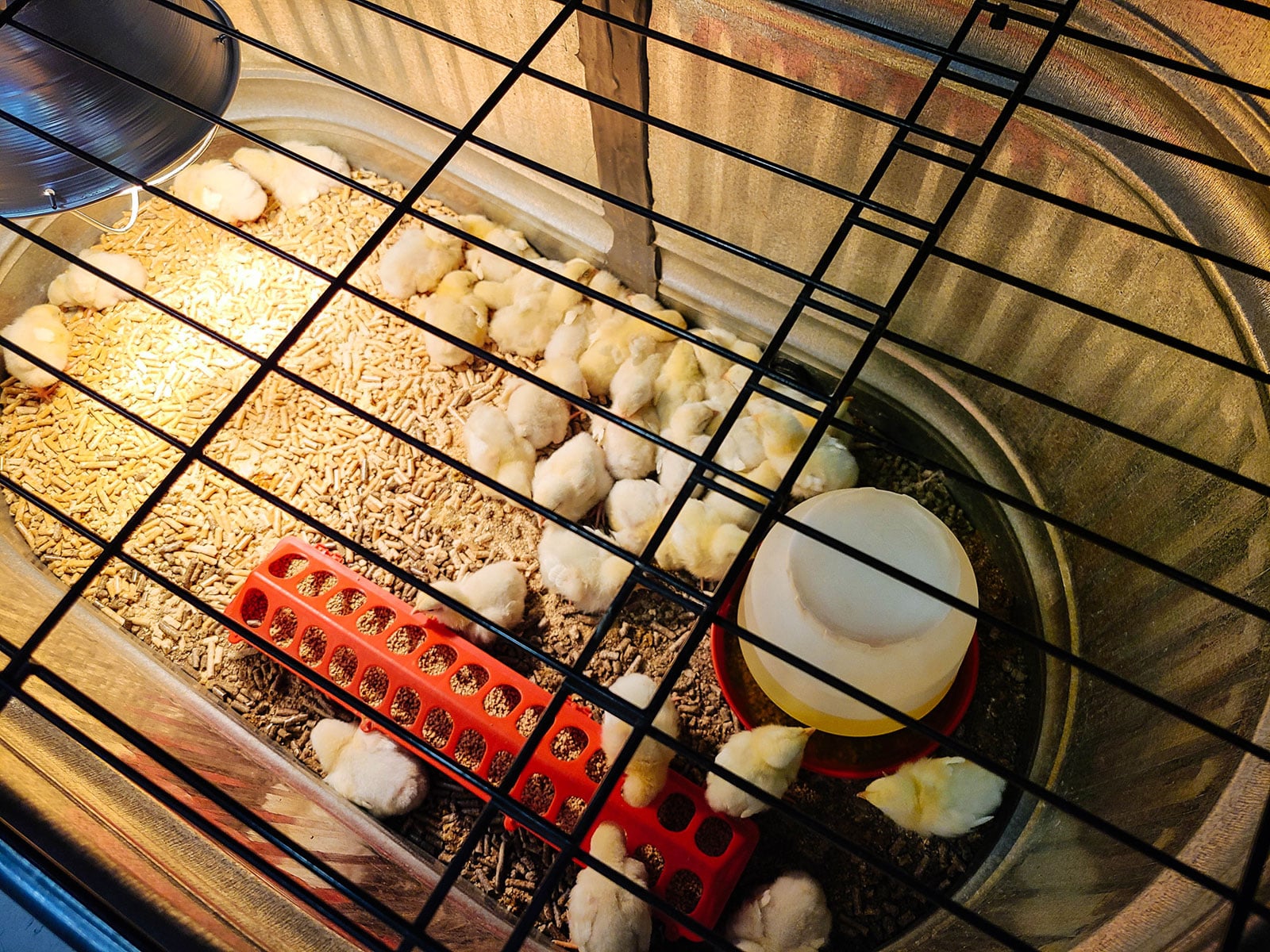
Each chick will need at least 6 square inches of space for the first two weeks, increasing to about 1 square foot per chick until eight weeks old.
So if you start with four chicks, for example, they would need a brooder box with about 24 square inches of empty floor space (not including the space taken up by the feeder and waterer). But chicks grow quickly and within a couple days, you’ll find that they become too active for this small amount of space.
By week two, you should allow for at least 1 square foot per chick, which should be plenty until they’re ready to go outside (weather permitting).
So those same four chicks will need 4 square feet of empty floor space. If you want to keep it simple, get a brooder measuring around 2 feet x 3 feet, which is a good size for the first eight weeks.
The brooder should be kept in a fairly warm and sheltered location, such as a spare room, laundry room, bathroom, or insulated garage or shed (as long as the garage or shed has windows or lights on during the day).
What I currently do for my brooder:
For the first two weeks, I use a cardboard box lined with a puppy training pad. This helps keep the dust down, the chicks won’t try to eat it, and it’s quick and easy to change out dirty training pads. I prefer to keep chicks contained to a smaller area at first (since it’s easier to heat), so the cardboard box works for me.
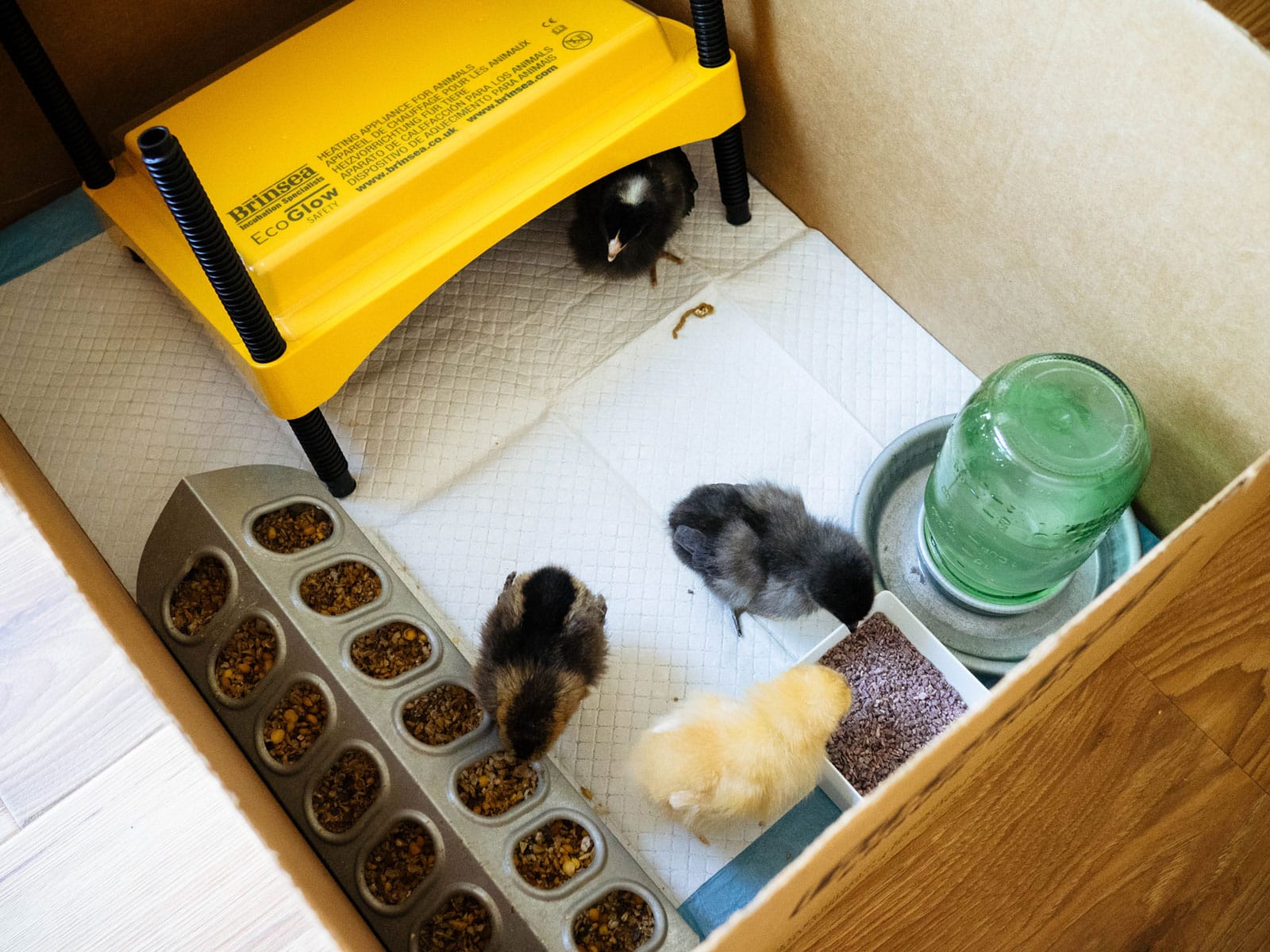
As they grow bigger and get feistier, I move the chicks into a portable puppy playpen that has a zippered top and a waterproof mat. I love this type of enclosure because it cleans up easily and folds away neatly when you no longer need it.
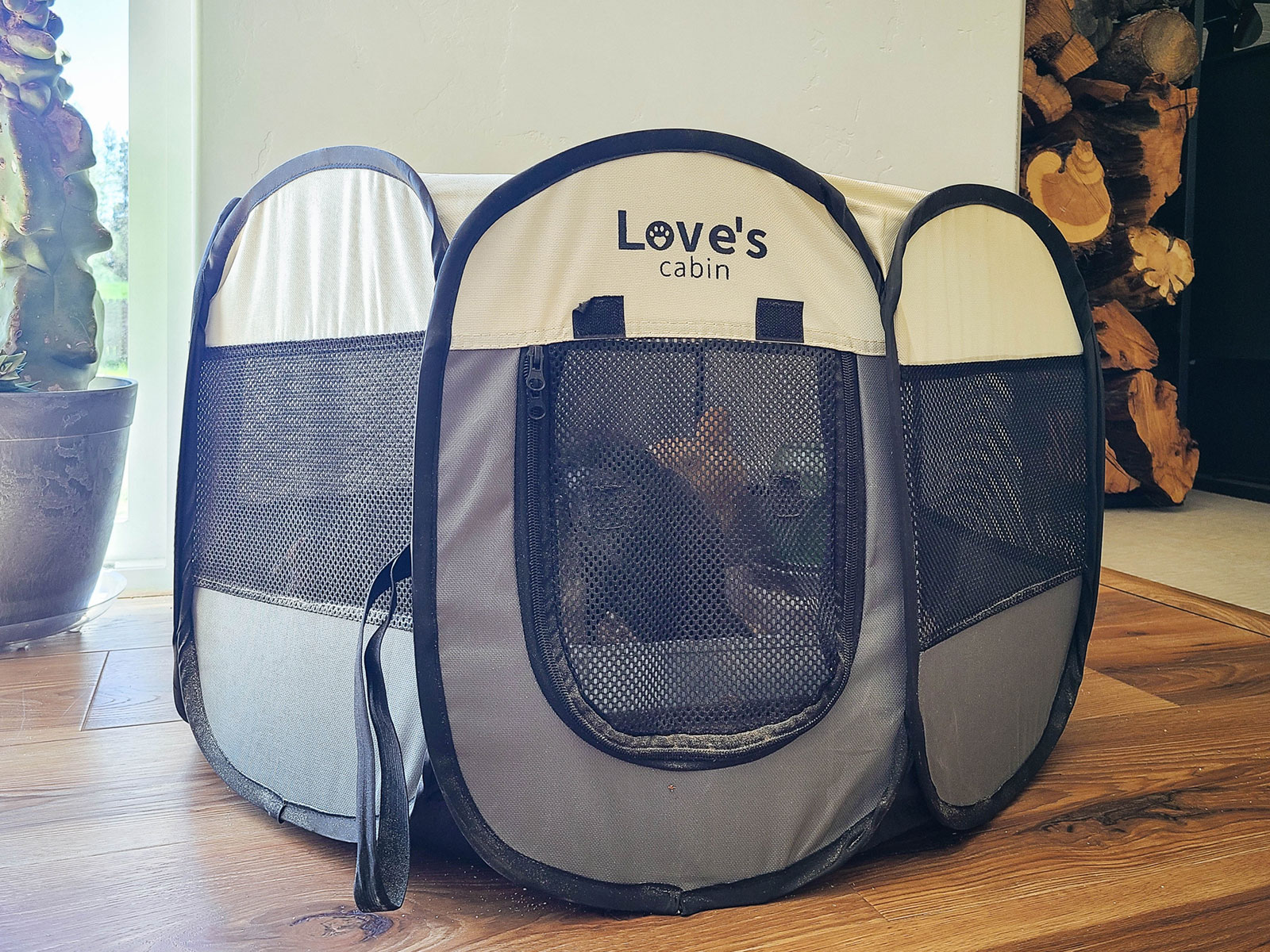
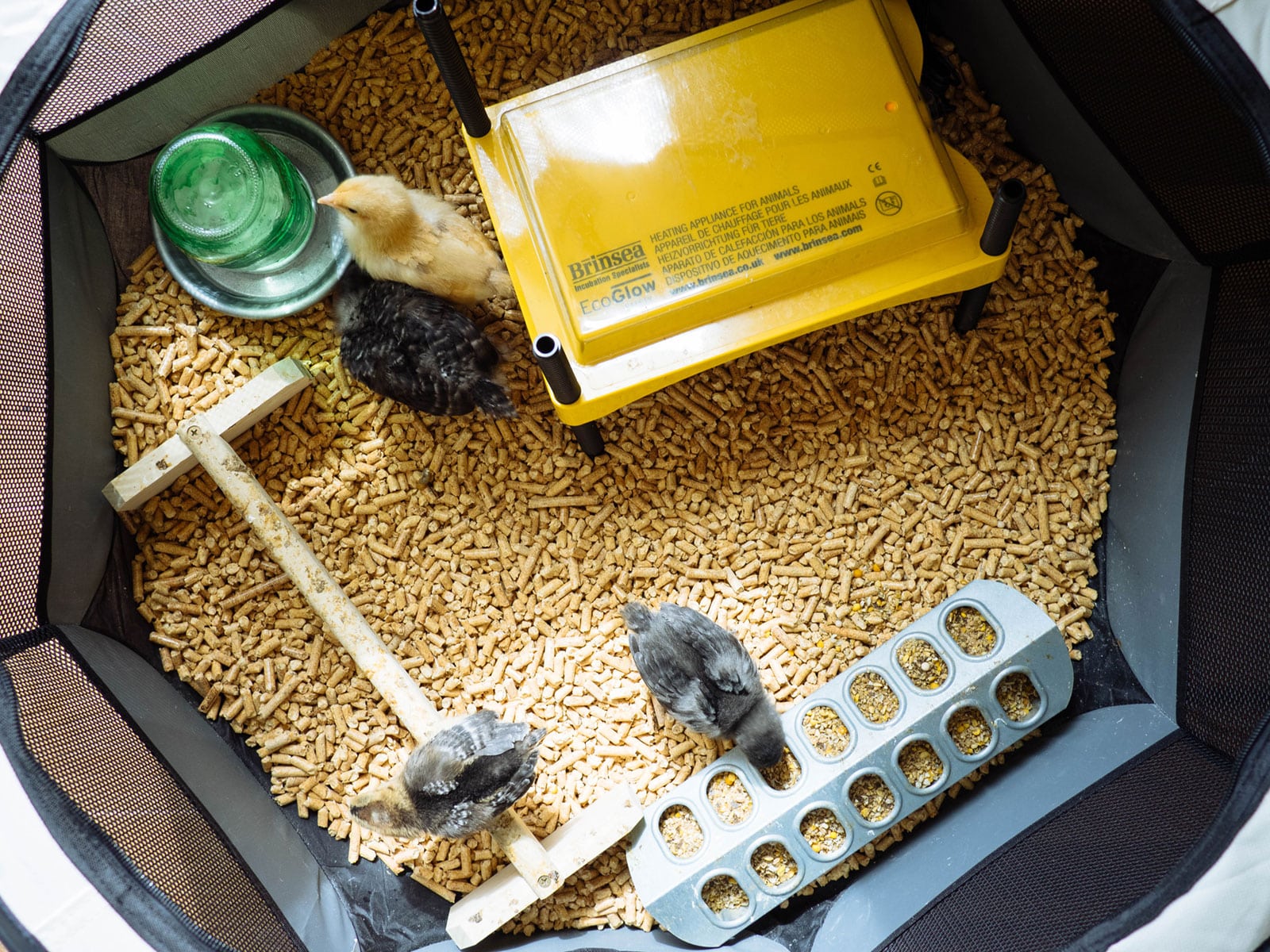
I use wood pellets in the playpen for bedding. This is the same material I use in the chicken coop, and I’ve tried a lot of things. I like pellets because they’re very absorbent, soft on the chicks’ feet, not as dusty as shavings, and in the compost pile, pellets simply break down into sawdust (their original state of clean wood fiber).
But you don’t actually have to buy wood fuel pellets for the brooder. (Save the good stuff for your grill!) You can often find pelletized pine bedding at feed and tack stores, which are less expensive and just as clean. Spread an inch or two of pellets across the floor of the brooder, then add them to your compost pile when they get too icky.
Where to buy
Arrival day
As soon as your chicks arrive, gently dip each chick’s beak in clean, room-temperature water. This shows them where their water is and triggers them to start drinking on their own. Providing room-temperature water instead of cold water helps keep their body temperature from dropping too much.
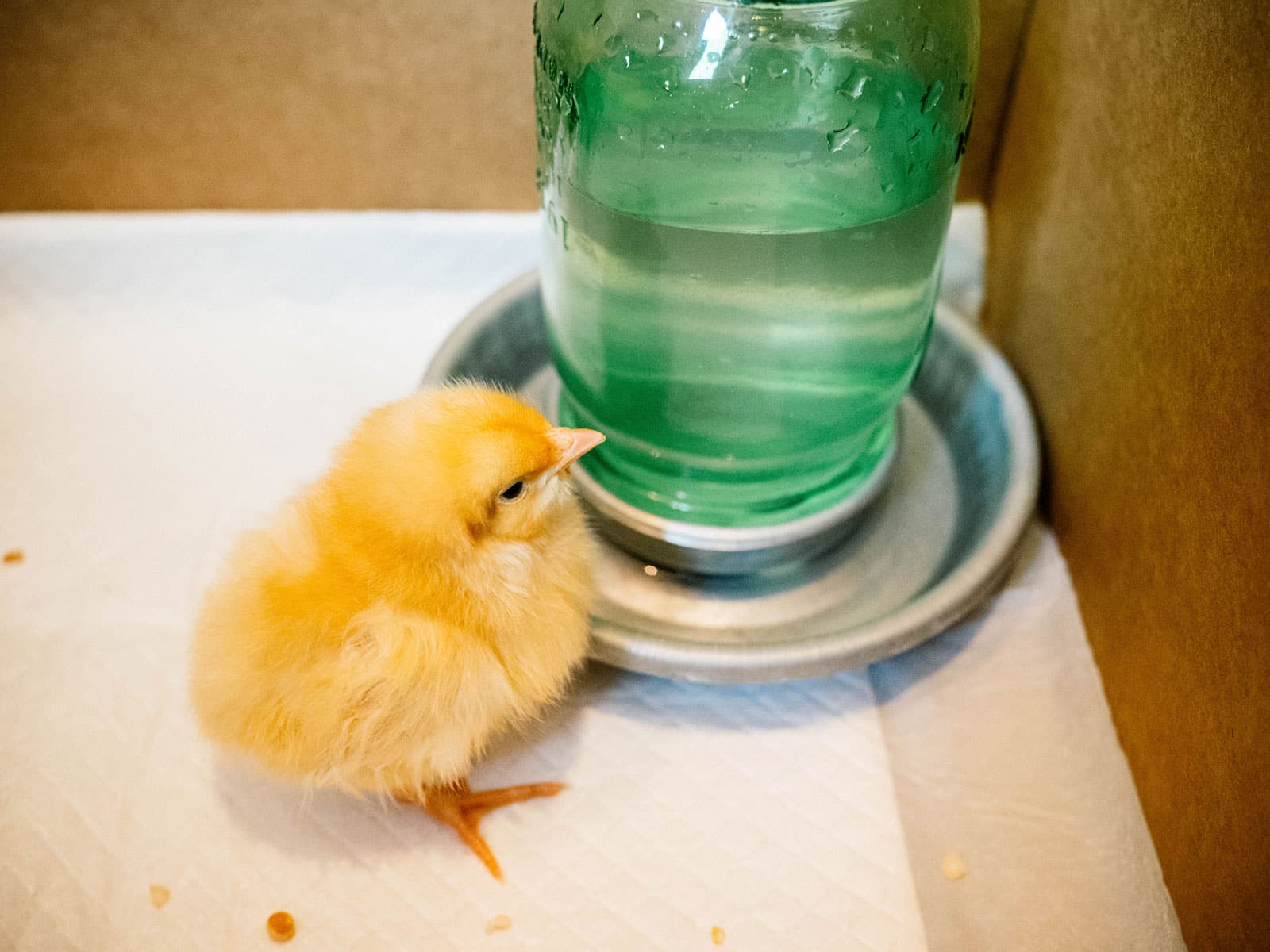
Let your chicks settle into their brooder and rest for the first day, and resist the urge to handle them. A new environment can be hard on chicks, so don’t be alarmed if they aren’t eating much or seem unusually quiet.
Keeping chicks warm
Warmth is one of the most important aspects of raising chicks. They need constant heat, even if they’re inside your home, because without feathers they can’t retain their own body heat. If they get chilled, they often can’t recover and will die. They also risk suffocation if they get too cold and pile on top of each other for warmth.
So always make sure it’s warm enough for them!
A brooder should stay between 90°F to 95°F for the first week, then incrementally decrease by about 5 degrees each week until the chicks’ feathers fill in. Every week, raise the heat lamp a bit or adjust the legs on the radiant heat plate to regulate the temperature as needed.
Quick tip
The entire brooder does not need to be 95°F—just the general area under the heat lamp or heat plate.
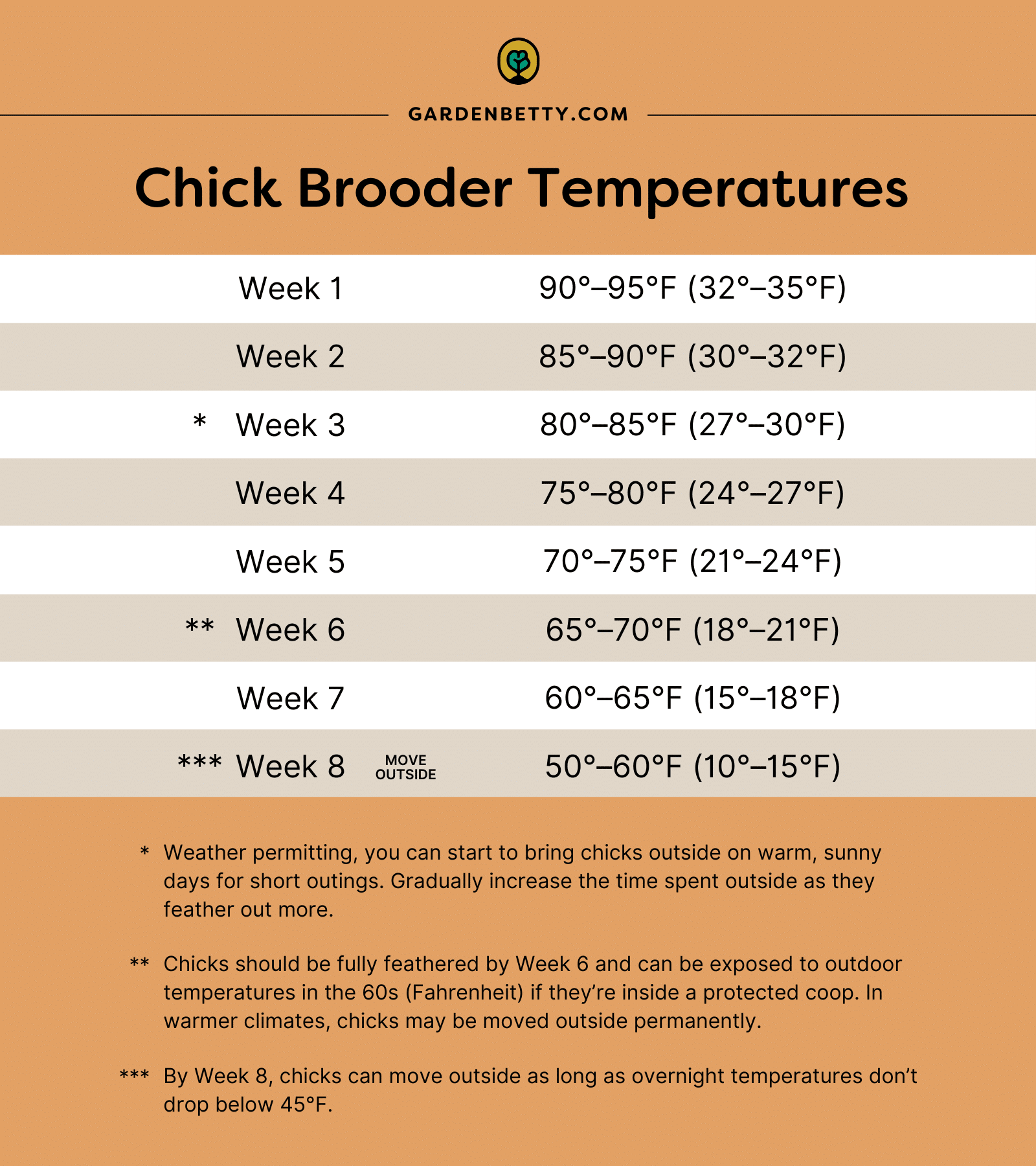
Place a small thermometer under the heat source, at chick level, to monitor the temperature. Chicks will tell you if they’re too cold or too hot.
When the brooder is too cold, they’ll chirp loudly and huddle together directly under the heat source. If the chicks are overheating, they’ll move away from the heat and pant or hold their wings out. (In my experience, it’s rare that the temperature inside the box ever gets too hot.)
Quick tip
If you use a heat lamp, it’s a good idea to keep a spare bulb on hand in case one burns out. You don’t want to be caught without backup heat!
Chicks that are happy and comfortable will be scampering around the brooder, eating, drinking, peeping quietly, and taking regular naps.
What I currently do for heat:
I used to use a red heat lamp, but have since switched to a radiant heat plate and I find it so much better (especially with little kids around). With a heat lamp, I was constantly worrying about the lamp falling over or getting too hot, and I didn’t love leaving it on all day when I wasn’t home.
A radiant heat plate, on the other hand, provides just the right amount of warmth and there’s no risk of catching fire. Even when the chicks (or you) are touching the heated part of the plate, there’s no risk of injury.
I use this model from Brinsea, which has adjustable legs so you can make it taller as your chicks grow. Typically I raise four chicks at a time, and the medium size provides enough room for them to grow.
I leave one side of the heat plate lower and the other side higher so my chicks can move where they feel most comfortable: toward the back for more heat, or toward the front for less heat. Sometimes the chicks will even sit on top of the heat plate to warm their bellies!
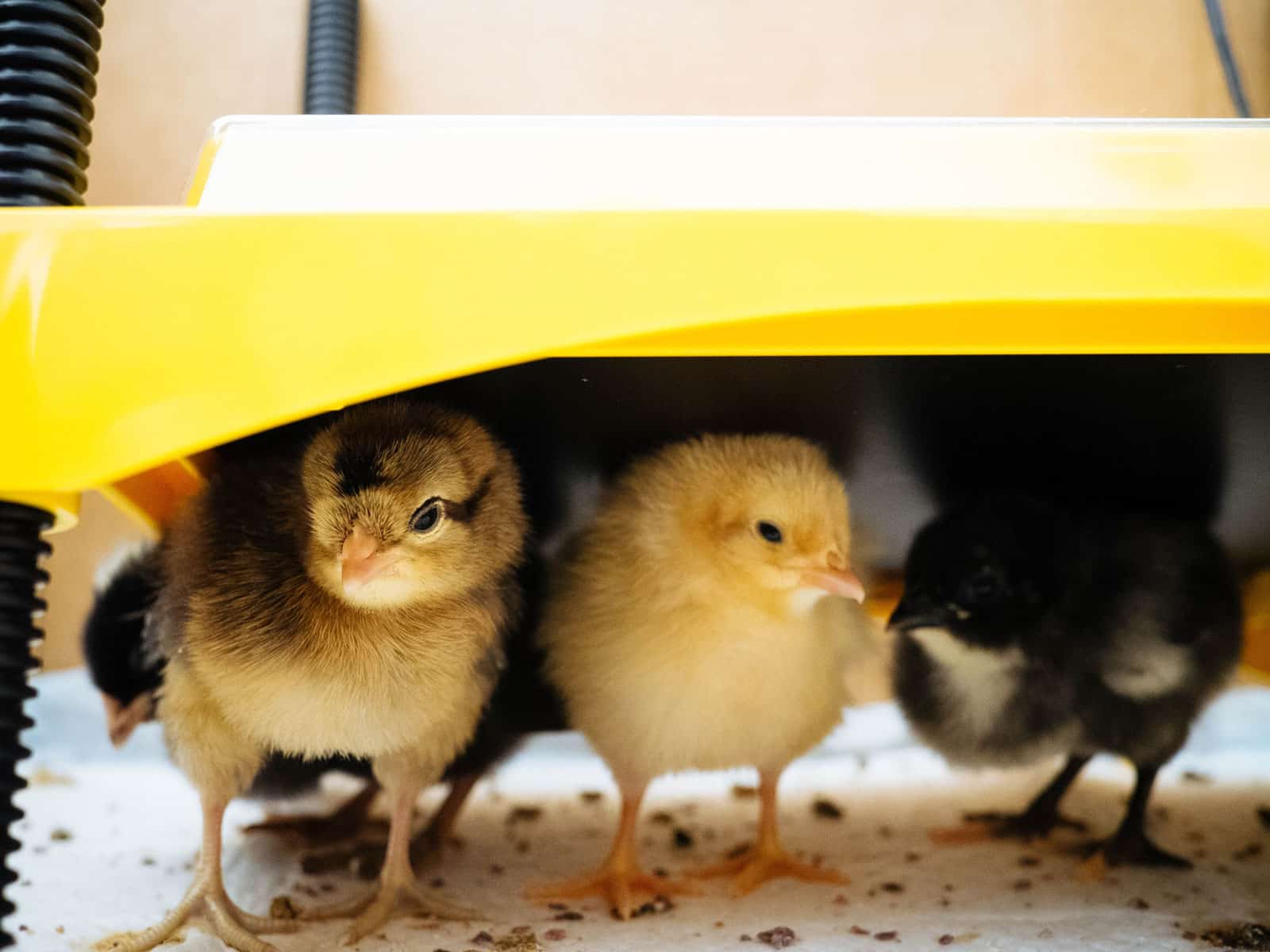
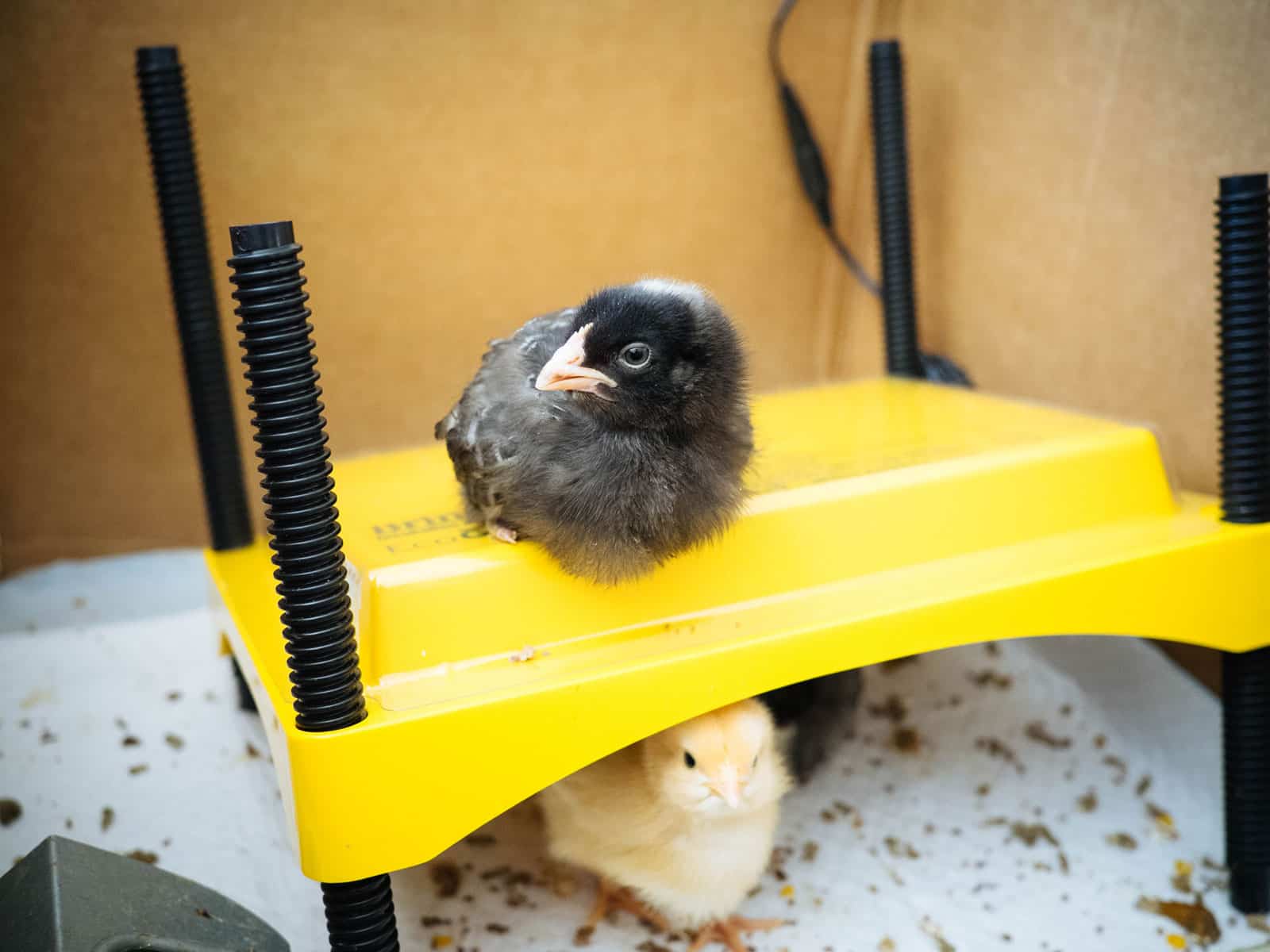
Around six weeks, when the chicks are fully feathered, I move the brooder into my garage near a window. This naturally lowers the temperature to start acclimatizing them, but the heat plate keeps them warm in case temps drop below 50°F at night.
Where to buy
Water and food
Water and food containers should always be kept within your chicks’ comfort zone in the brooder—that is, not right under the heat source but not too far away from it. You don’t want your chicks getting too hot or too chilly to get to them.
Water
Always have fresh, clean, room-temperature water available in the brooder 24/7. For mail-order chicks, adding electrolyte powder to their water for the first few days can help maintain proper hydration and support their adjustment to a new environment.
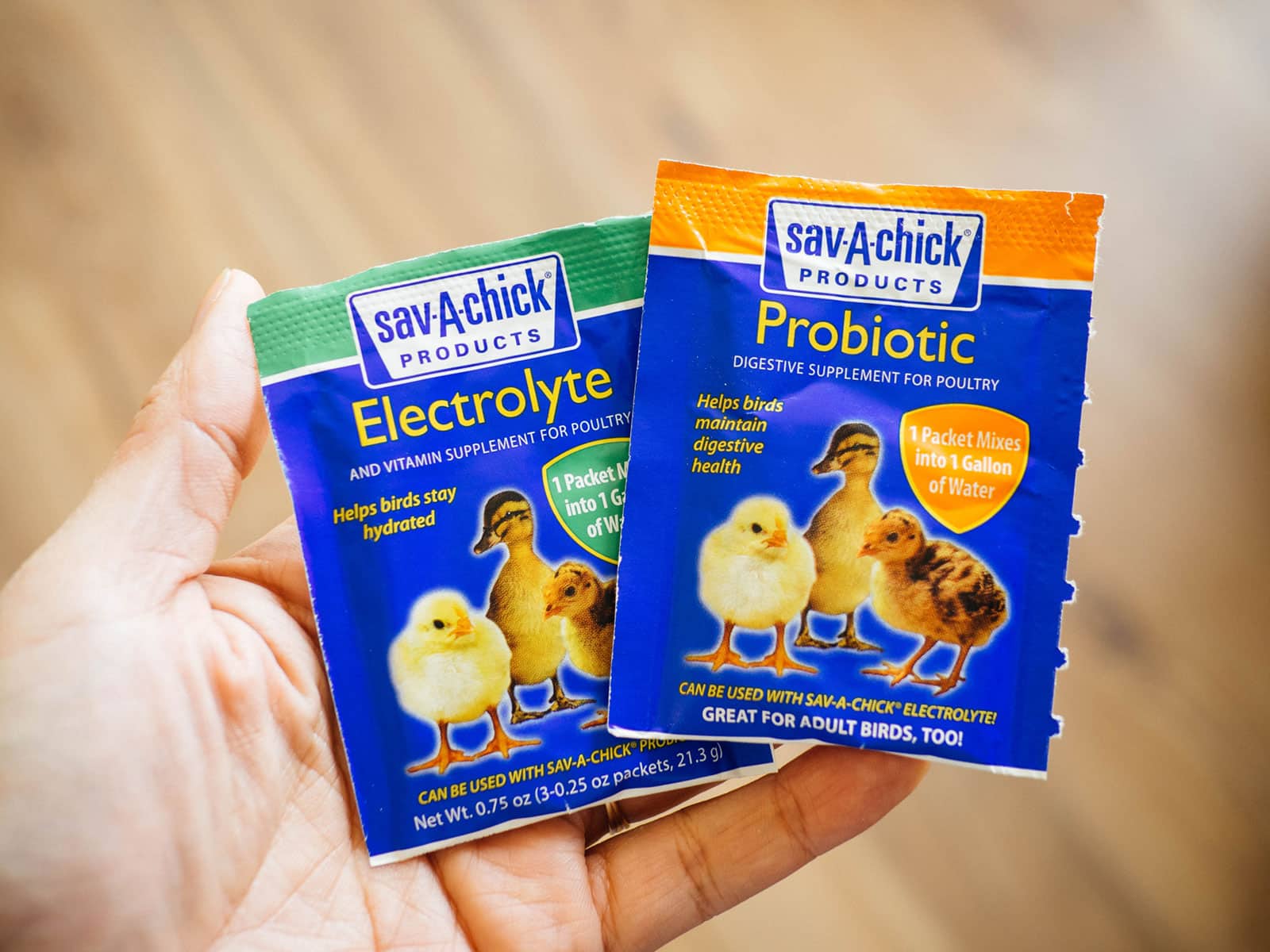
I personally like to use both electrolytes and probiotics in their water to boost their immunity, aid in nutrient absorption, and give them a strong start. (Yes, you can mix them!)
Where to buy
Chick feed
Baby chicks need their own type of food called chick feed or starter feed. Most chick feed is a high-protein ration of around 20 percent protein to help baby chicks get off to a good strong start and feather out faster.
Chick feed comes in two forms:
- Starter crumbles, which look like Grape Nuts cereal and are made by crushing pelleted feed into smaller pieces
- Starter “mash,” which—contrary to how it sounds—is actually individual whole grains and seeds combined into a complete feed
If you decide to feed a starter mash, you should place a separate dish with chick grit next to the feeder. Chicks help themselves to the grit as needed, which helps them digest the grains and seeds more easily.
(You don’t need to offer grit if you’ll be feeding starter crumbles.)
Where to buy
What I currently do for chick feed:
I use a starter mash, as it more closely resembles the soy-free and corn-free chicken feed I make at home for my laying hens.
And depending on space, I’ll either offer a container of chick grit or put a mini dust bath in the brooder (more on that in the next section below) so chicks always have a source of grit available.
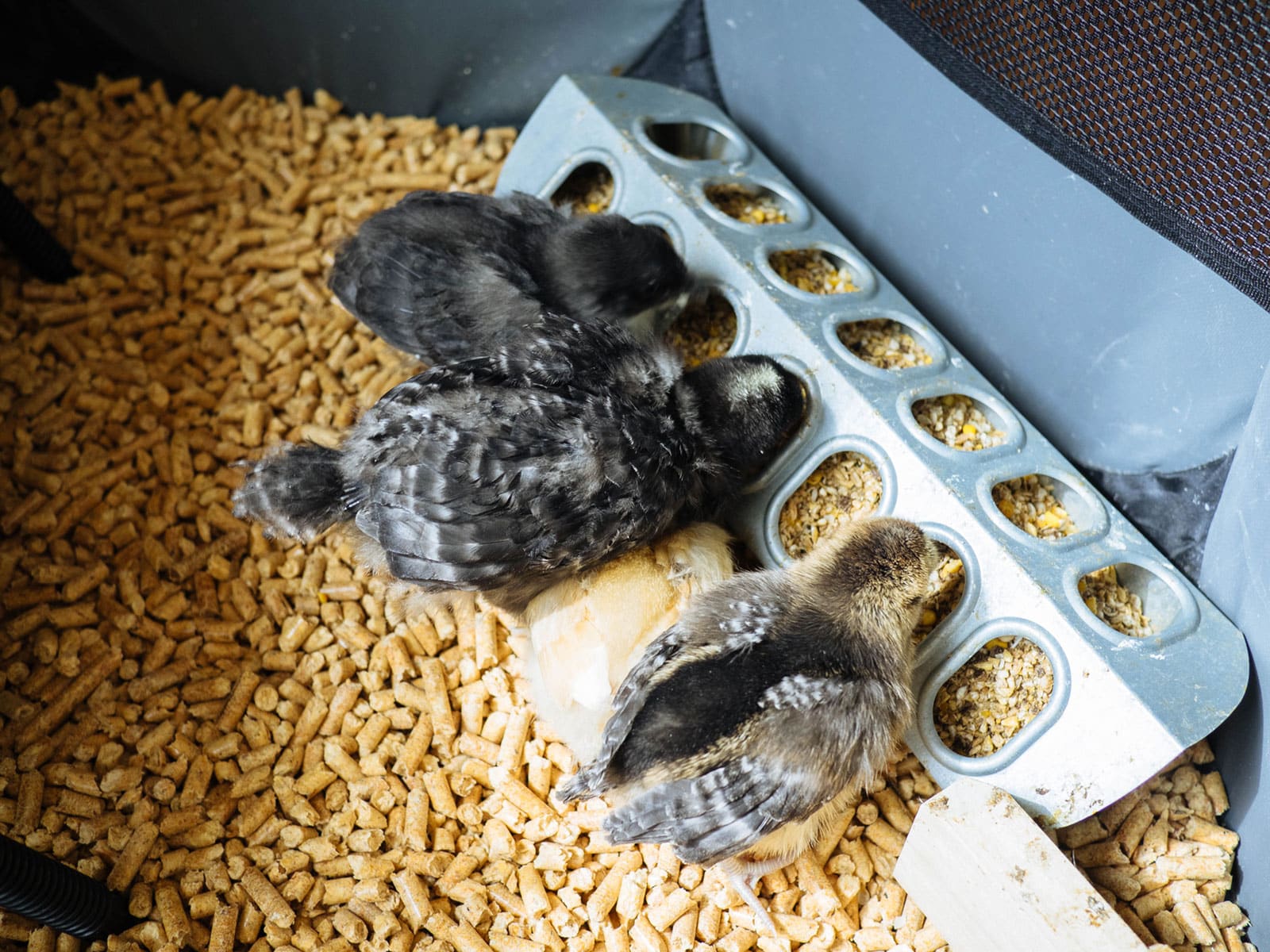
Quick tip
As your chicks get bigger, you’ll want to elevate their waterer and feeder so they don’t kick so much of the bedding material into the containers.
Should you use medicated feed?
There’s a lot of debate in the chicken-keeping community about whether or not you should use medicated feed. Stores sell both medicated and non-medicated feed, and choosing one or the other is a personal decision that you have to make for yourself.
When I raised my first batch of chicks many years ago, I gave them medicated starter feed because that’s what the store had front and center. But on my second and subsequent batches of chicks, I used non-medicated feed.
Medicated chick starter contains a thiamin blocker (Amprolium) that helps reduce the chances of coccidiosis in young birds. Coccidiosis is a condition in which protozoal parasites (oocysts), which naturally live in the soil and in your chickens’ intestines, become too widespread for the chicken to handle and make her sick. The oocysts spread through feces and can infect an entire brood. If left untreated, coccidiosis often becomes fatal, and it’s one of the leading causes of death in baby chicks.
So why wouldn’t you give medicated feed to your chicks?
- If your chicks were vaccinated, the vaccine neutralizes the medication.
- Medicated feed can only work if your chicks are simultaneously exposed to coccidia protozoa. Meticulously removing every dropping from the brooder and keeping your chicks away from soil prevents them from building resistance to coccidiosis.
What I currently do to build immunity:
I use non-medicated feed but I also help my chicks build immunity as soon as I bring them home. Since it’s usually too cold to let them explore outside in early spring (at least until they start to feather out), I bring the dirt to them—and put it right in the brooder.
I like to make a mini dust bath for my chicks using coarse dirt from my yard and often toss a small clump of grass or weeds into the brooder as well. It keeps them occupied and provides low-level exposure to oocysts and other pathogens in the soil, which boosts their immune system naturally.
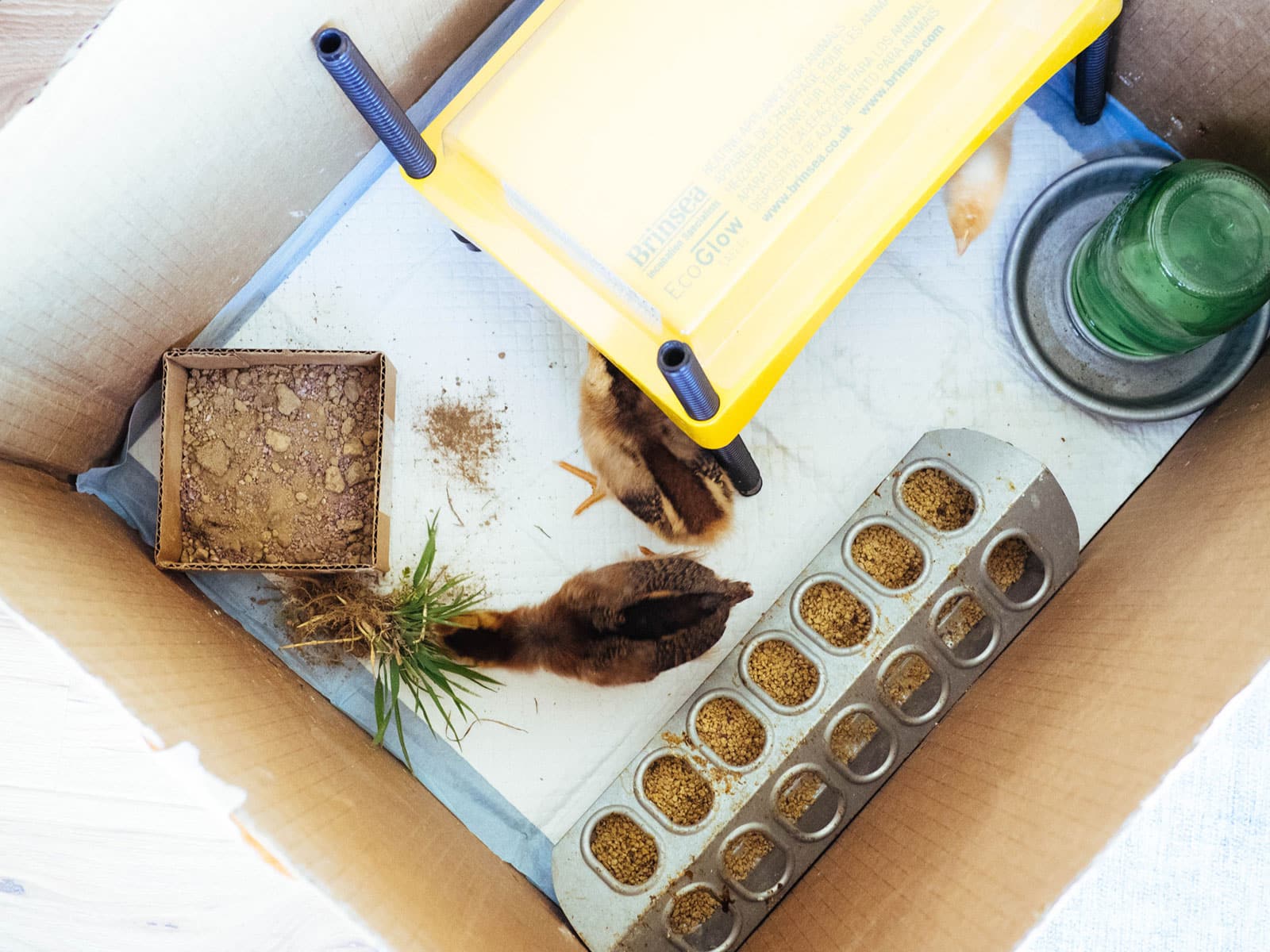
This mimics the way chicks are raised by hens outside. As soon as the babies are dry, give or take a few days, exposure begins and they learn to be chickens by scratching in soil for food. Subsequently, hen-raised chicks rarely get coccidiosis.
Transitioning to grower feed and layer feed
Once the chicks turn eight weeks old, switch them to grower feed (unless they’re already eating a starter/grower combo feed) to slow down their development and keep them healthy. Grower feed is typically around 17 percent protein. Make the transition gradual by mixing increasing amounts of grower feed with decreasing amounts of starter feed over a few days.
By the time your chicks (now pullets) are 18 weeks, they can move on to 16 percent layer feed to get ready for laying eggs. Just like you did before, mix in the layer feed with their grower feed a little at a time to transition your chickens gradually.
When they’re ready to lay, offer free-choice calcium (such as crushed oyster shells or crushed eggshells) in a separate container near the feeder.
WHere to buy
Treats and chick grit
Do baby chicks get treats just like older hens? Sure—but sparingly. I typically wait until they’re a few weeks old before I begin offering treats, and when I do, I make sure there’s a source of chick grit in the brooder.
Grit helps baby chicks digest what they eat, and store-bought chick grit is specially sized for their tiny beaks. If you raise chicks with their own mini dust bath in the brooder, then the coarse dirt you provide is already a good source of grit. Otherwise, place a small dish of grit in the brooder, separate from their food.
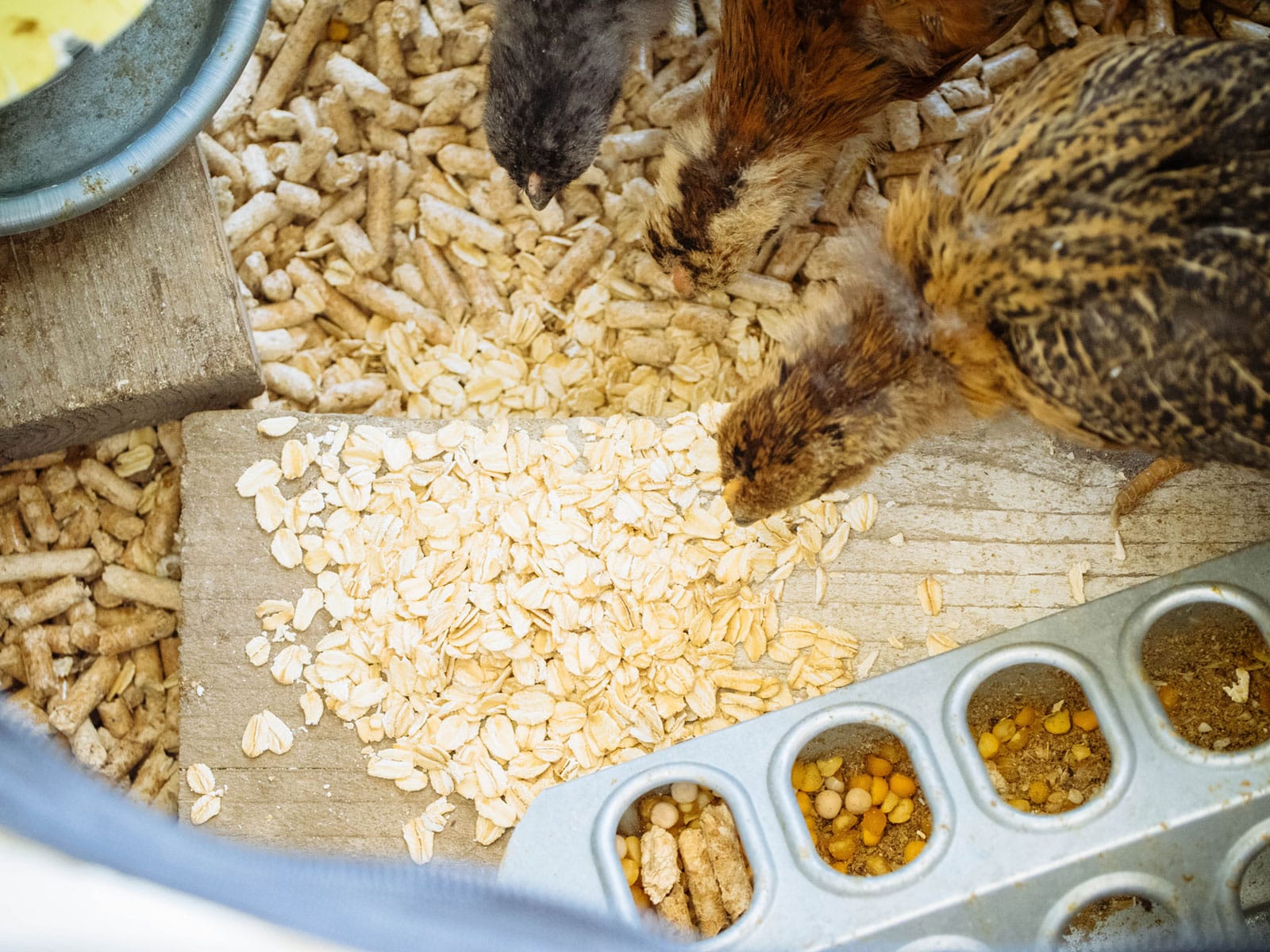
Occasional treats can include weeds, fresh herbs, leafy greens, scrambled eggs, or raw oats.
Where to buy
Handling your chicks
Chicks are quite malleable at their age and will form a strong bond to you if you handle them regularly. But start slowly: don’t just reach in to the brooder and pluck them out without warning. Set your hand on the floor of the brooder with some chick feed in your palm, inviting the chicks to approach you.
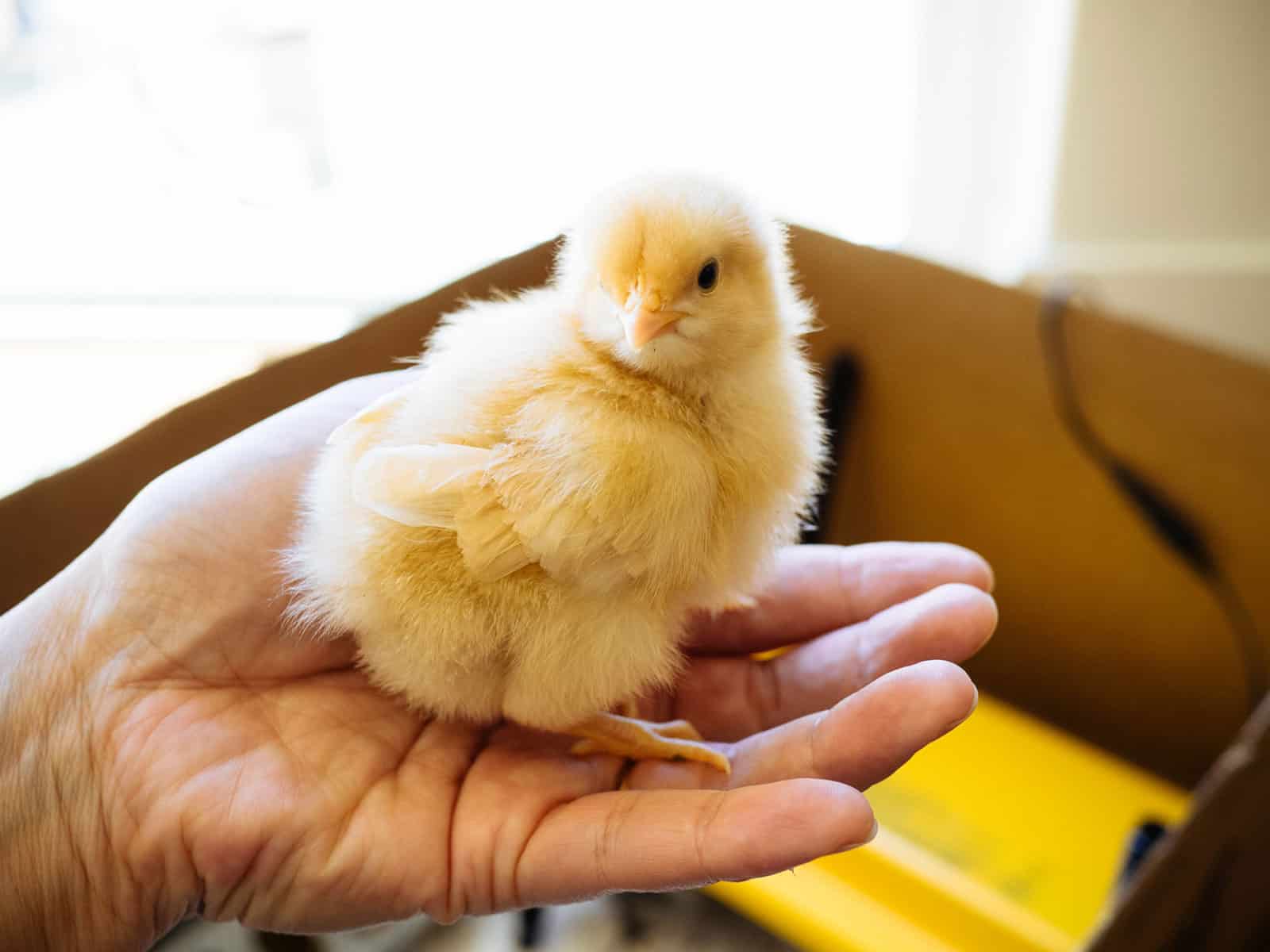
Once they’re comfortable with your presence, feel free to pick them up for some snuggles outside of the brooder. Be attentive to their behavior, as chicks will shriek if they’re scared or cold. Some enjoy being handled more than others, so you don’t want to stress them unnecessarily.
Cleaning the brooder
Your chicks should have fresh water daily, and their feeder cleaned and replenished as needed.
Chicks poop a lot, and their poop gets bigger and stinkier as they grow! In the beginning when my chicks are on a puppy training pad, I change the pad daily. But once they transition to a larger brooder lined with pine pellets, I only change the pellets every week or two.
You have to strike a balance between keeping the brooder clean, but not too clean that your chicks can’t build immunity.
Indoor roosts
Yep, chicks love to roost, even if they aren’t sleeping on it right away. Give them a flat, wide roost, which is easier to perch on than a round dowel. It will help them get used to roosting in the big coop, which makes them less likely to sleep in the nest boxes later.
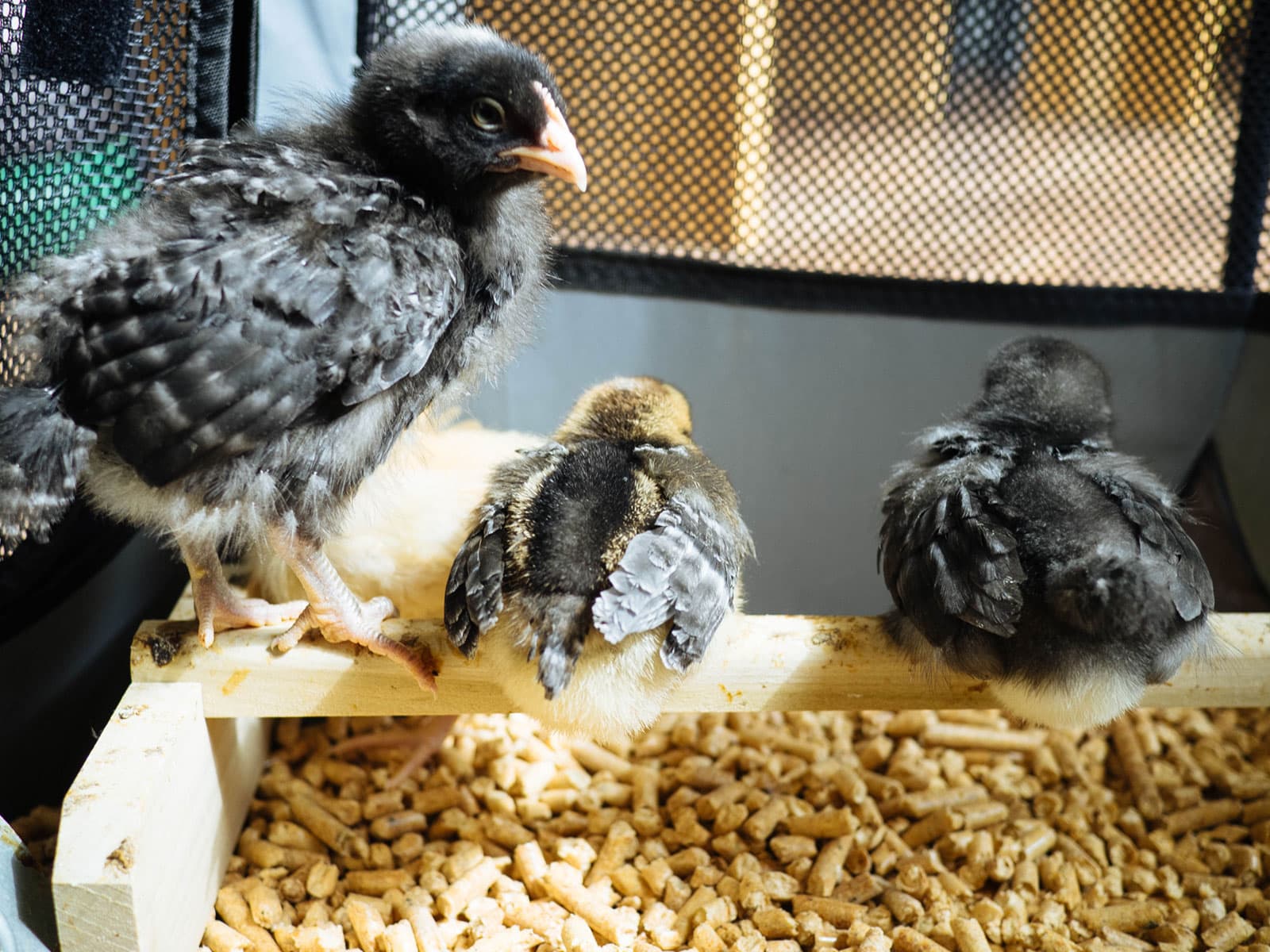
If you have room inside the brooder, place a small branch or rock as additional perches they can explore.
Where to buy
Letting your chicks play outside
Once your chicks start feathering out around three weeks old, you can bring them outside for short adventures on warm, sunny days in the grass or in the dirt.
I bring my chicks in and out of the house in a large bucket and use another pop-up playpen (with the floor zipped out) to keep them confined and safe while able to scratch in the grass. It’s set up in a spot that gets both sun and shade, where I can monitor the chicks the whole time I’m working in the yard.
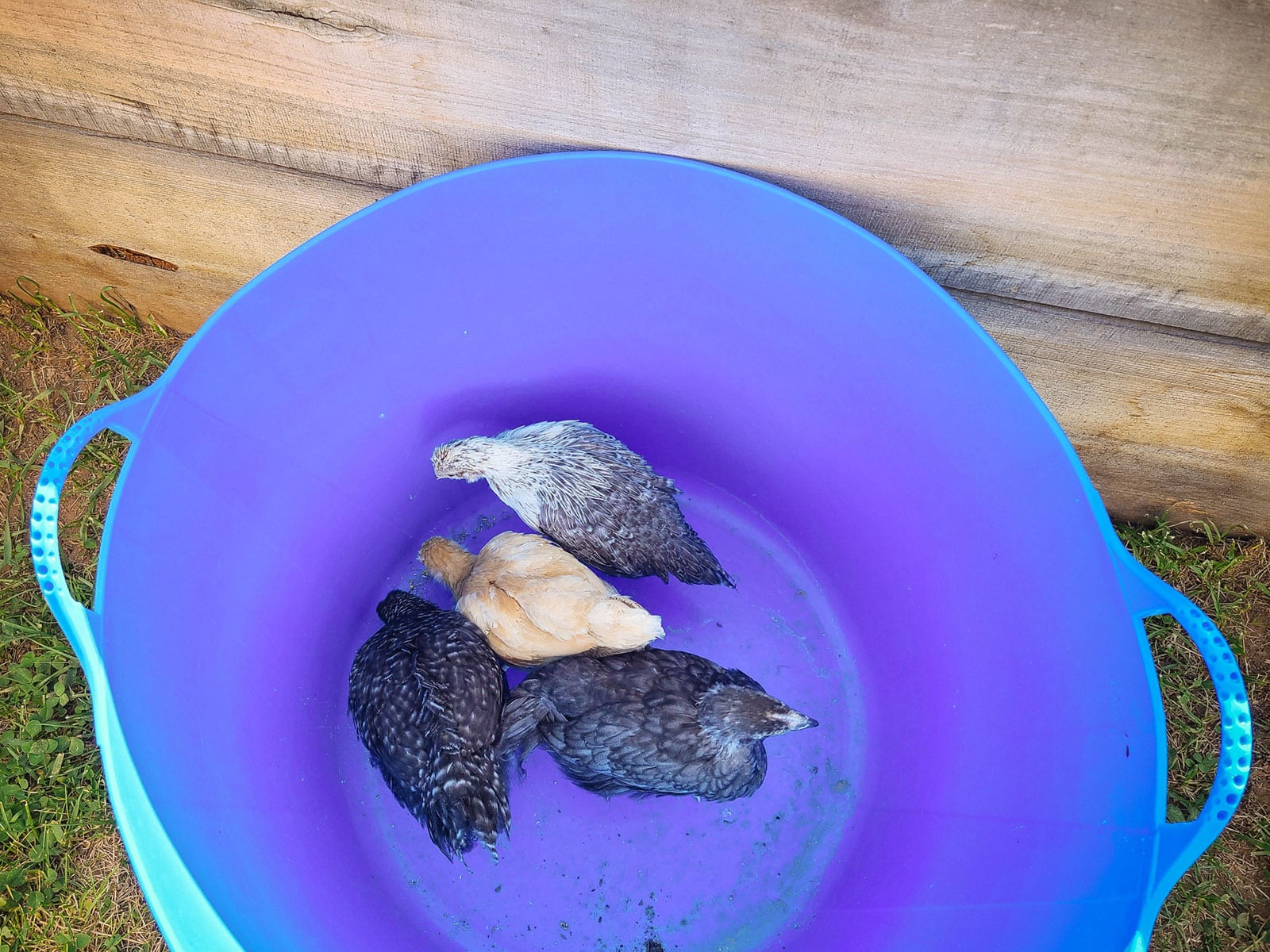
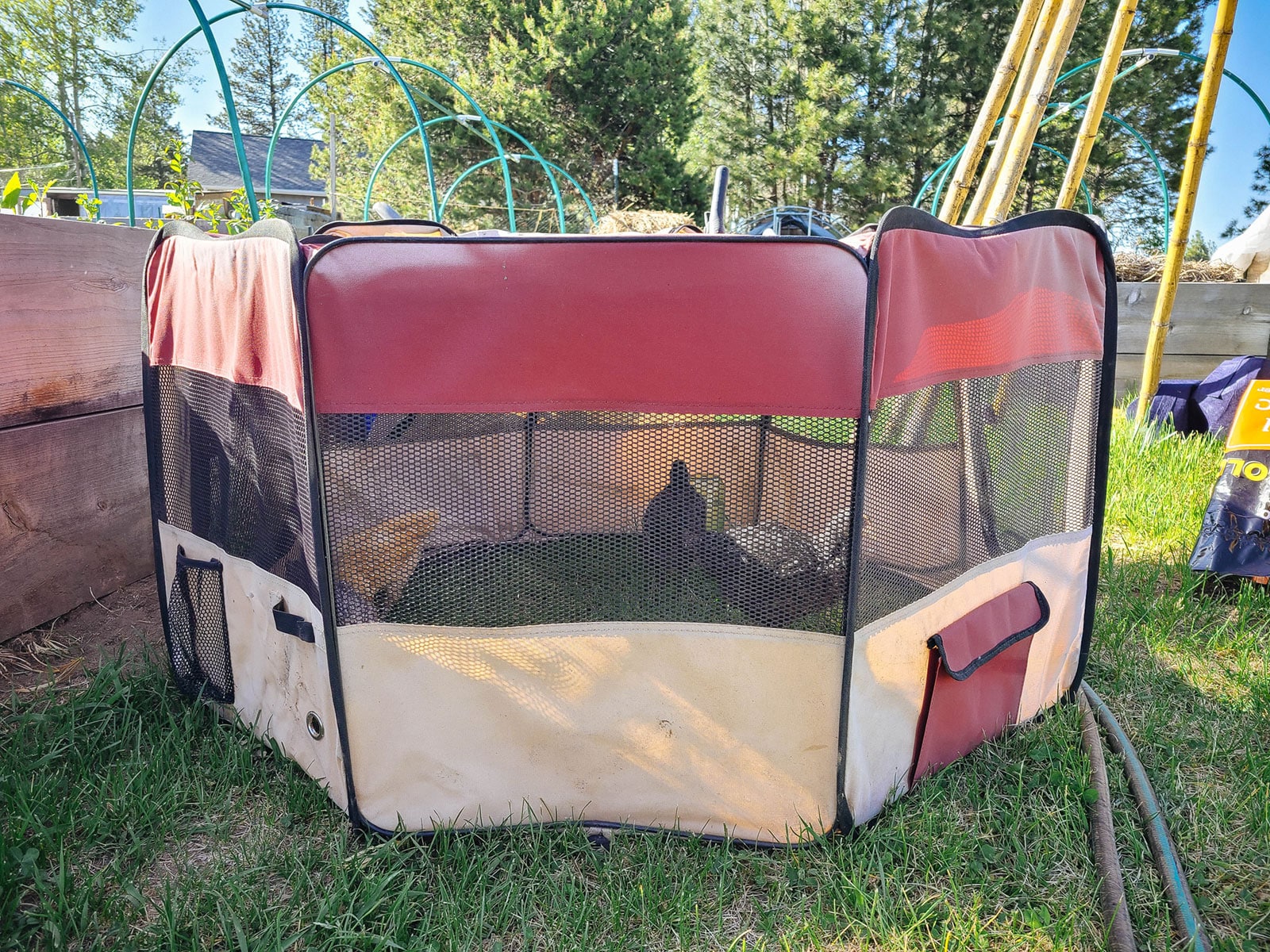
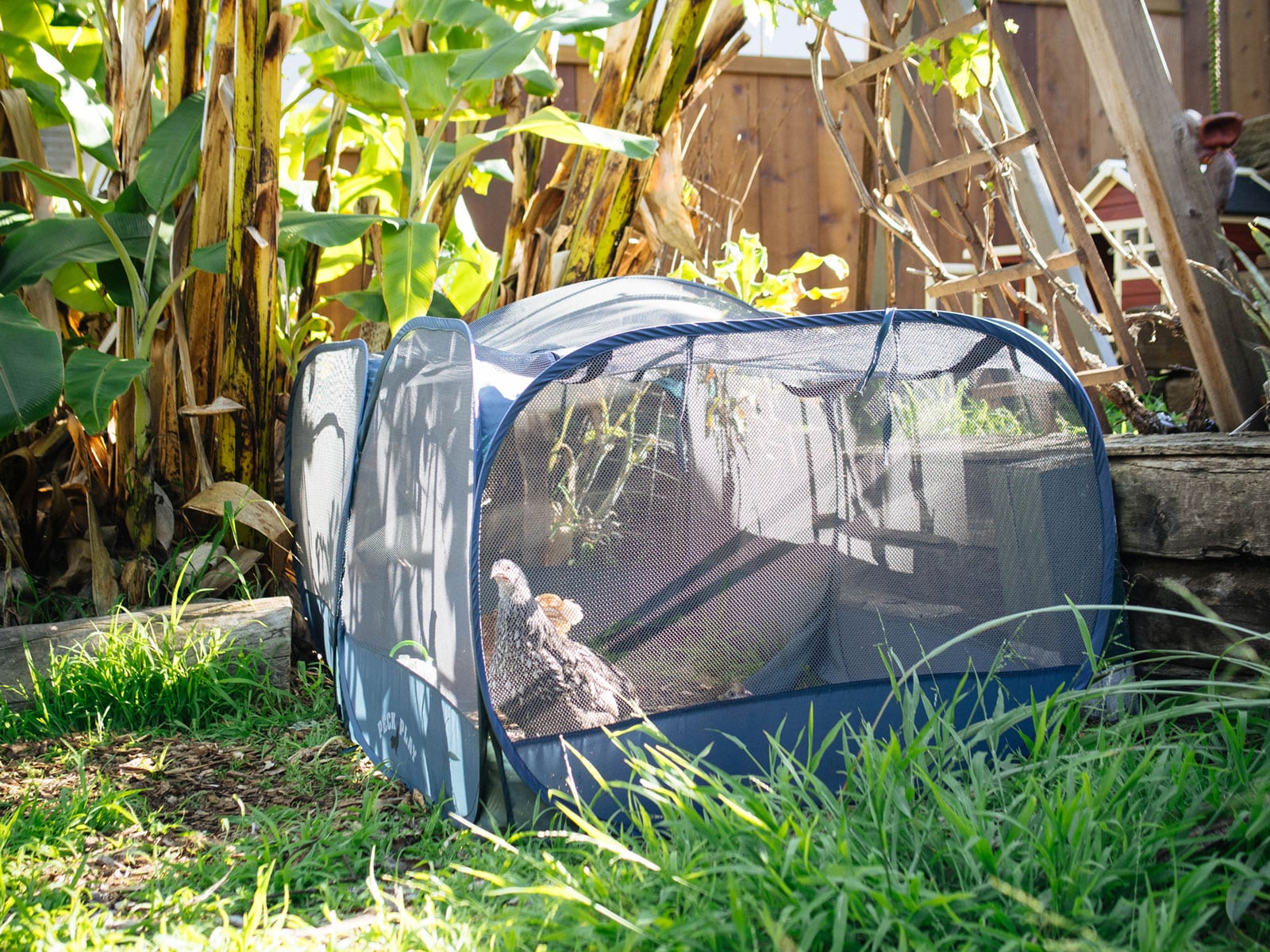
It’s important that chicks have access to fresh water at all times. Keep an eye (and ear) on their comfort level as they’re very susceptible to overheating or getting chilled at this age.
As they get older, gradually increase the amount of time they spend outdoors until they’re eight weeks old, when they’re fully feathered and should be ready to move to the coop (as long as overnight lows don’t drop below 45°F).
Where to buy
Adding new chickens to an existing flock
If you already have chickens, it’s crucial to integrate the new and existing flocks gradually. This makes it safer for all of them as it limits the spread of disease and keeps picking to a minimum.
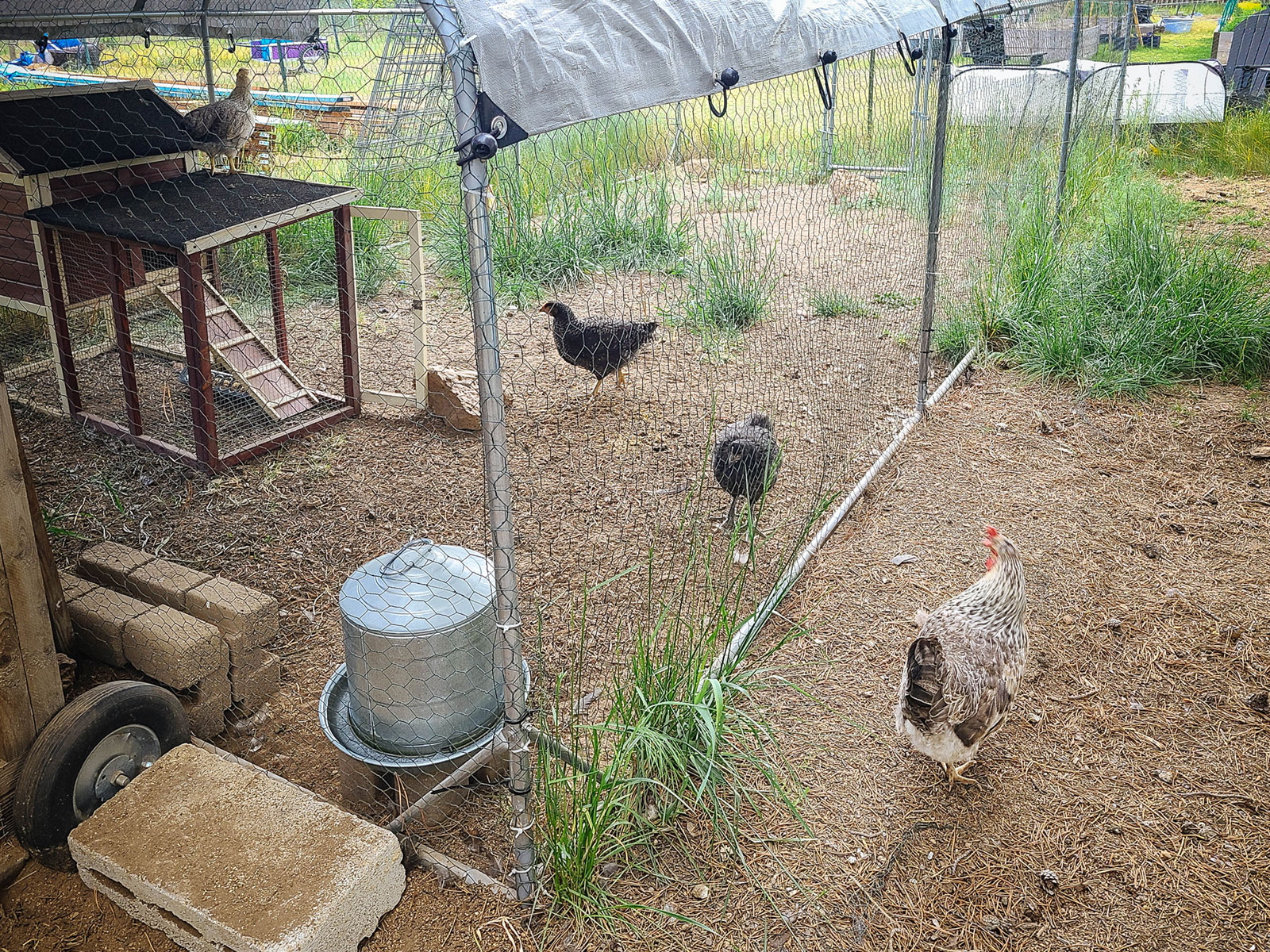
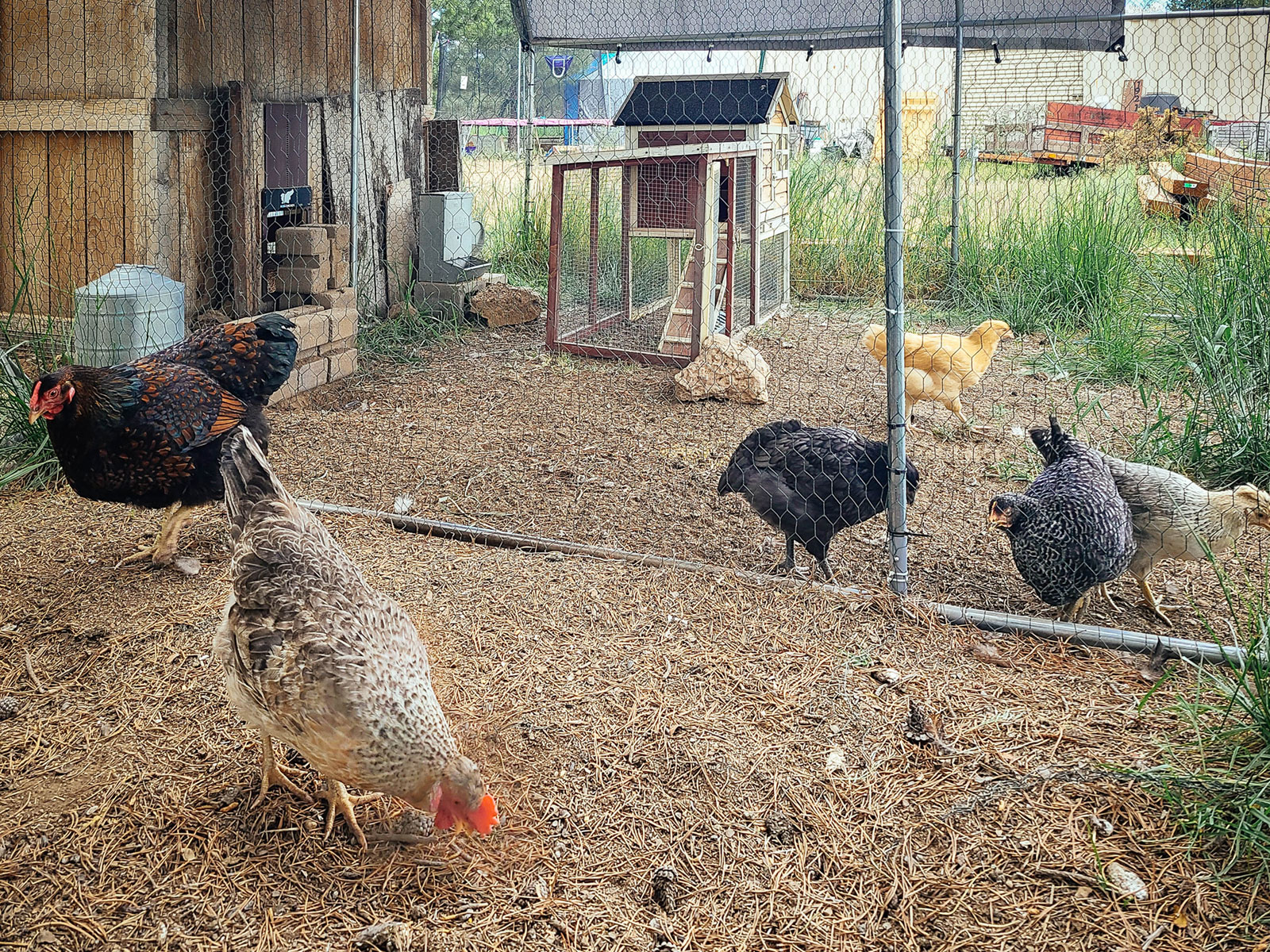
Important things to know:
- Keep the new and existing flocks separate at first (“look but don’t touch”).
- Combine the flocks when all the chickens are about the same size.
- Scuffles are inevitable as the two flocks establish their new pecking order. Let your chickens figure it out on their own unless their behavior is overly aggressive or causes injury.
- New chickens should sleep in their own coop during the “look but don’t touch” period. (I like to use a rabbit hutch for this, but any cheap mini chicken coop or small enclosure with a roost will work.)
- Chickens can’t see in the dark, so when it’s time for both flocks to sleep in the same coop, slip the new chickens in at night for a smoother transition.
- Chickens will compete for food and water, so make sure there’s an additional feeder and waterer in the run.
I wrote a complete guide here on how to properly quarantine and introduce new chickens to your flock.



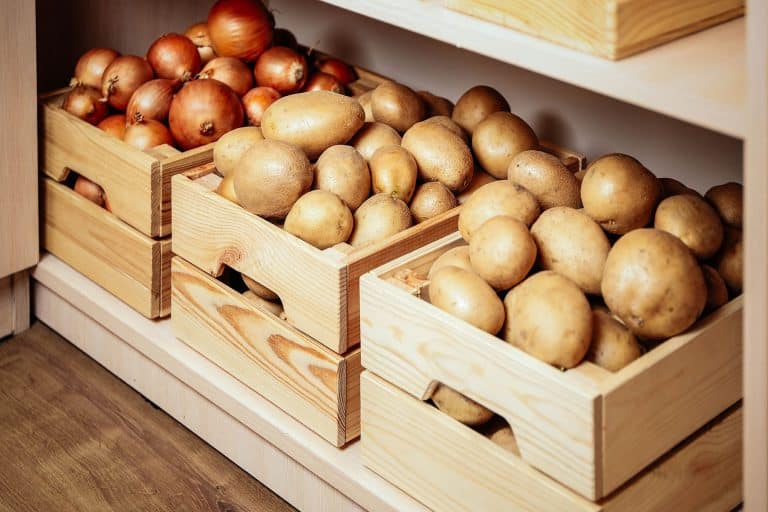

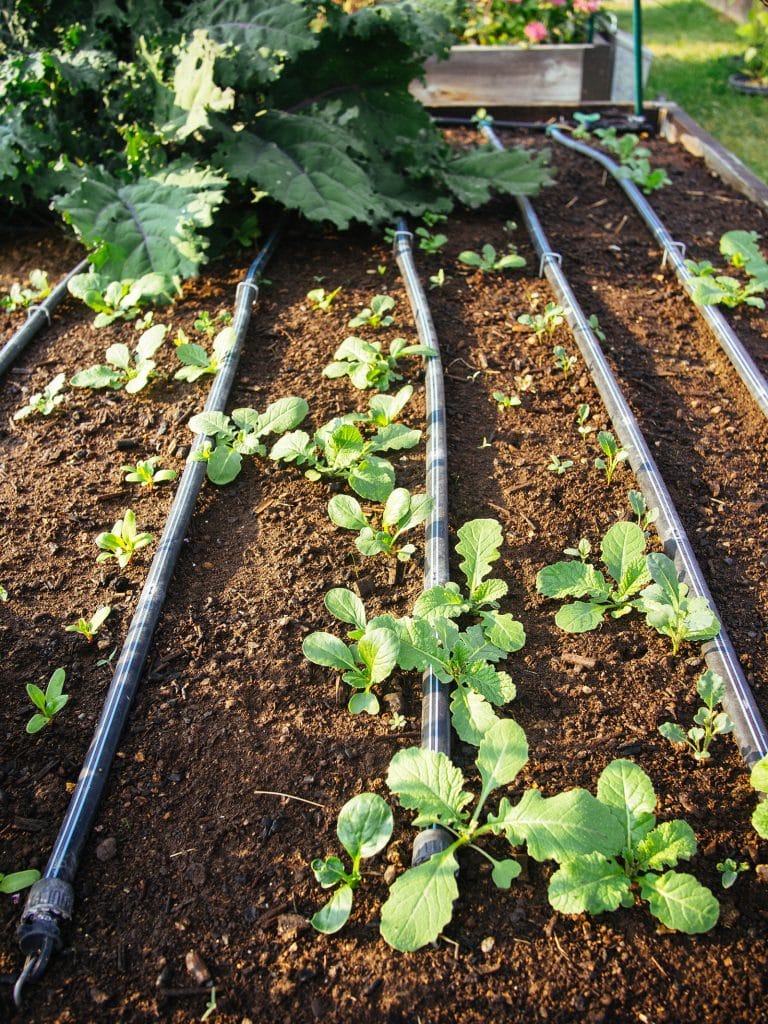
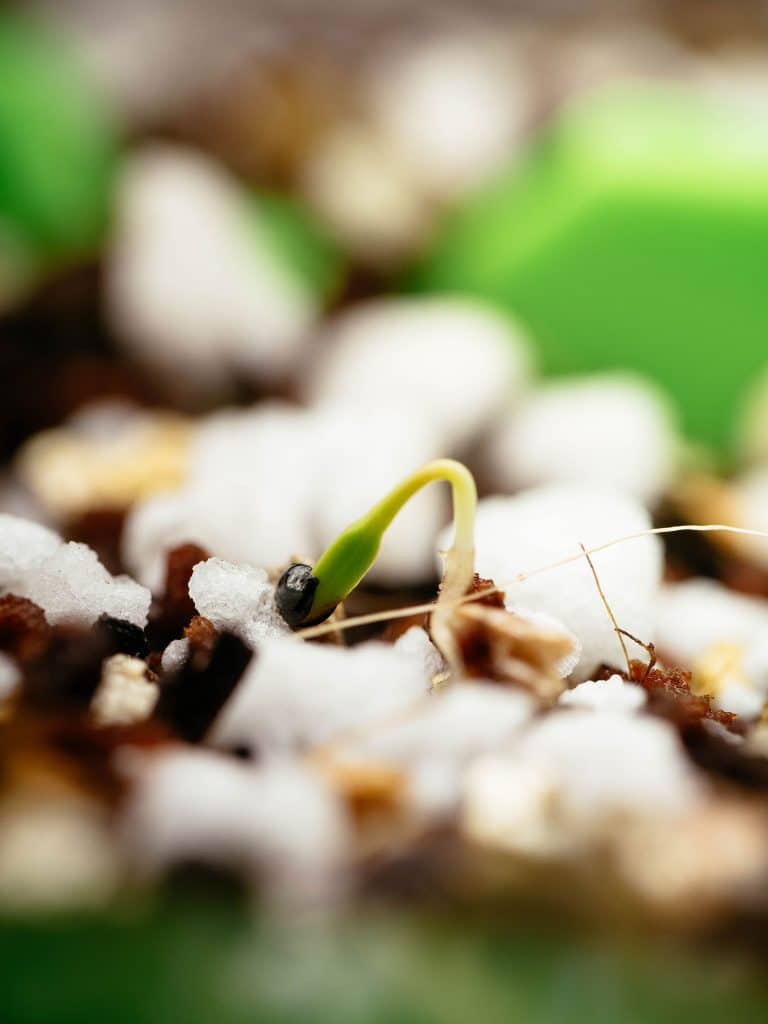



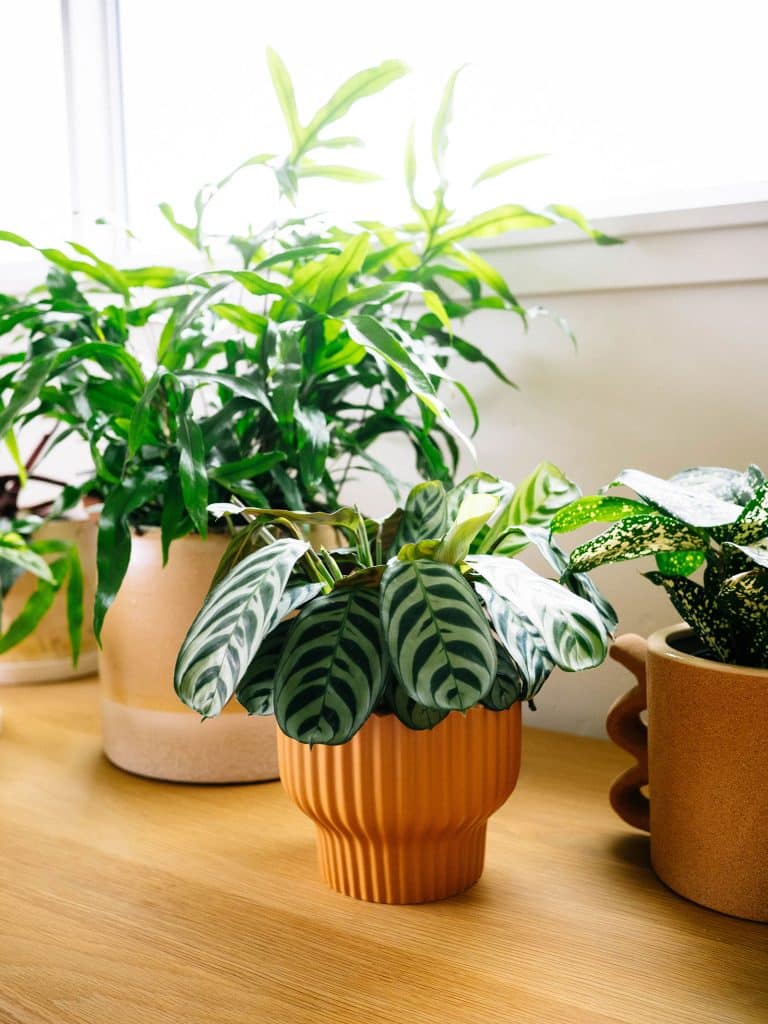
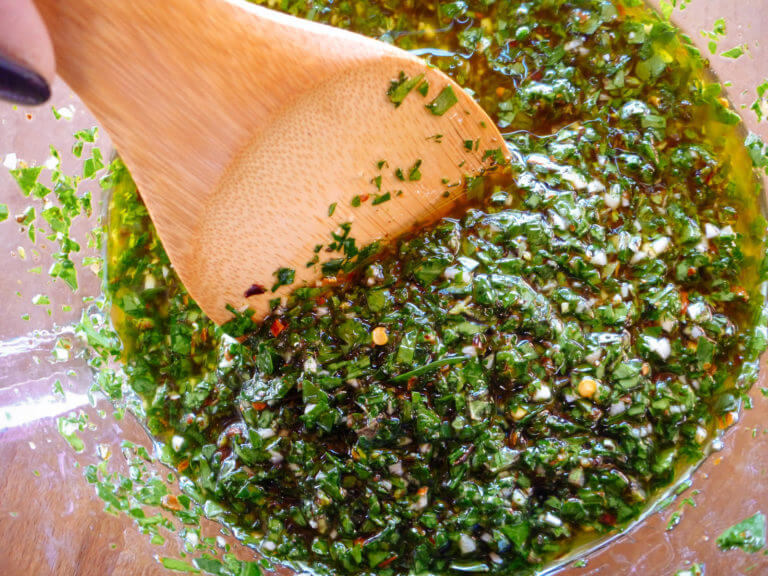
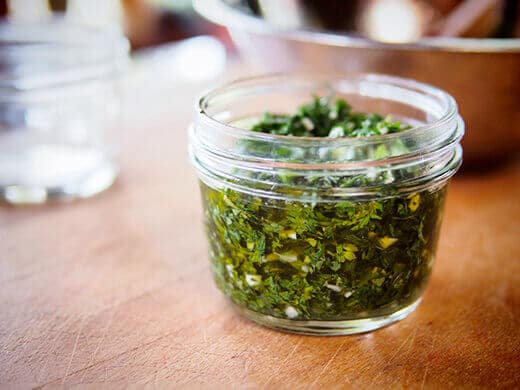

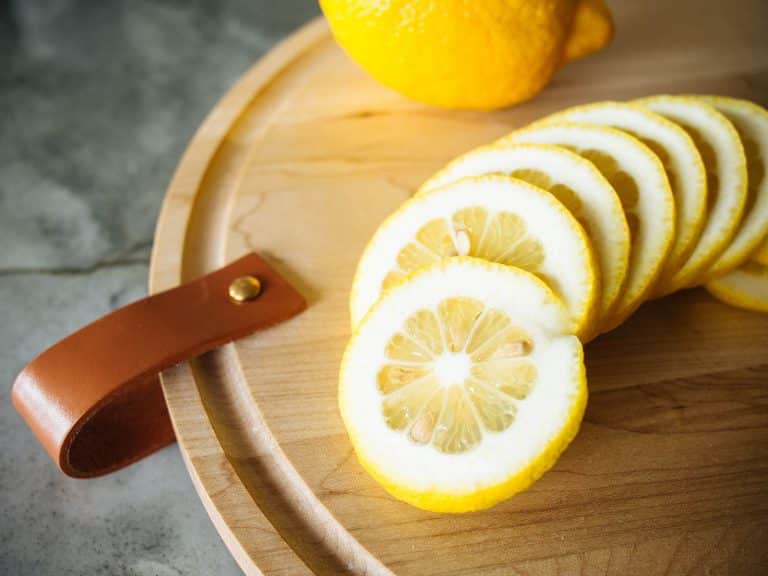

Nice one. I have found that a 100W incadenscent lightbulb with a reflector works for up to 100 chicks, my usual order via mail. As mail delivery became more and more unreliable, we started buying from feed stores. With orders by mail, I’d order what amounts to the hatchery leftovers, which provided chickens of several breeds. I would order straight run, meaning both sexes. Fifty cockerels were not to many for roasters, and 50 replacement stewing hens met my stewing hen needs. When I could not find unmedicated chick starter, I used the unmedicated layer mash that I was feeding my adult flock anyway. THE MOST IMPORTANT REASON FOR USING UNMEDCATED FEED is that feeding antibiotics to livestock is probably the most serious reason why antibiotics used in medicines develop antibiotic-immune strains of bacteria. Bacteria can pass small packages of genetic material to other bacterial species through small gene packages called phages. This results in resistance to bacteria being spread throughout our environment, most seriously within hospitals. Apparently the agricultural lobby is stronger than the medical lobby, so the practice of generally dosing livestock, because it is cheaper than calling-in a veteranian in the uncommon instance that it actually gets sick. I read about this problem in a Scientific American magazine in the early 1970’s and it remains a problem, though a little progress has been made. The last time I ordered leftover chicks, they turned out to be 100% cockerels. This resulted in a horrible situation for our 25 or so hens until we butchered them. Most of the hens eventually were compensated by having their own date with the hatchet put of a year.